The 100 Best War Movies of All Time
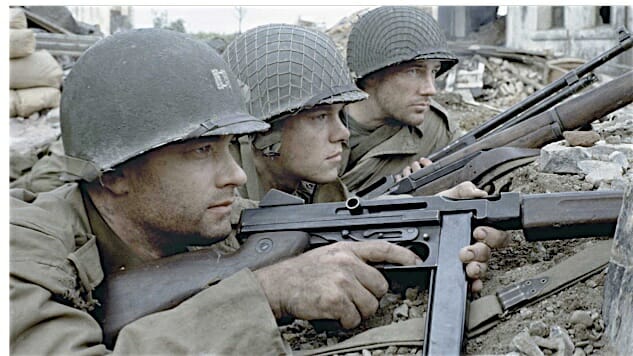
War. What is it good for? Well, if nothing else, then a tidy template for cinema: The best war movies have conflict, clear protagonists and antagonists, heightened emotions, and a generally unpredictable, lawless atmosphere which—as per the western—has, since the dawn of cinema, offered an elastic dramatic environment in which filmmakers can explore men at both their best and worst. And make no mistake, the war movie is almost always about men.
It’s the most masculine of genres, the fact that armies have throughout history often been almost exclusively male seeing to it that men almost always dominate these things. It’s a genre that emphasizes action and existential angst. It’s also a malleable genre, and one that could broadly include all manner of films that we ultimately ruled out of the running in this list.
With this top 100, we’ve made the decision to include only movies whose wars are based on historical conflicts, so none of the likes of Edge of Tomorrow or Starship Troopers. We’ve picked films that deal with soldiers, soldiering and warfare directly, meaning wartime movies set primarily away from conflict, often told largely or exclusively from the civilian perspective—a category which includes such classics as The Cranes Are Flying and Hope & Glory, Grave of the Fireflies and Forbidden Games—didn’t make the cut. Post-war dramas, like Ashes and Diamonds and Germany, Year Zero, as well as films that go to war for only a fraction of the running time, such as From Here to Eternity and Born on the Fourth of July, were also excluded.
Some tough choices were made on what actually constituted a “war movie.” Resistance dramas feature in this list, but Casablanca doesn’t appear. Likewise Robert Bresson’s A Man Escaped and Sidney Lumet’s The Hill. It was decided ultimately that the war was too much a peripheral element in these films. On the other hand, while both western The Good, The Bad and The Ugly and biopic The Imitation Game feature war prominently, they, like Casablanca (a romance with noir and thriller elements) plus A Man Escaped and The Hill (both prison movies), belong more obviously to other genres. We’ve also decided not to include movies which focus on the Holocaust here; those are set to appear in another feature entirely.
Regarding the films that do feature here: our 100 hail from all over the world. These films were released as recently as last year and as far back as 1930. They range from comical to harrowing, action-packed to quietly introspective, proudly gung-ho to deeply anti-war.
They are a diverse set of movies; they are also worthy of being called the 100 best war movies ever made.
100. Merry Christmas, Mr. Lawrence (1983)
Director: Nagisa Oshima

Merry Christmas, Mr. Lawrence may be the first film to confront and then attempt to understand the flawlessness of David Bowie’s charm. Pretty solidly a superstar by this point and already flush with acting experience, Bowie plays Major Jack Celliers, an impudent British officer captured by the Japanese during the thick of World War II and sent to a POW camp on Java overseen by Captain Yanoi (Ryuichi Sakamoto, a legendary musician in his own right, who also provides the film’s searing neon score). Yanoi struggles to suppress his obsession with this new prisoner, knowing full well the severe punishment that awaits any homoerotic activity under his army’s strict bushido code. Merry Christmas, Mr. Lawrence is a quiet film, unhurried and rarely manic: Long shots wander over barracks full of dirty, downtrodden and sometimes destroyed prisoners, but always Oshima finds his way back to the saint-like Bowie, who skirts the line between wit and tragedy, mean-mugging while the camera laps up his every microgesture. —Dom Sinacola
99. Days of Glory (2006)
Director: Rachid Bouchareb

The little-discussed plight of the ill-treated North African soldiers who valiantly fought for the Allied Forces in WWII (and were subsequently denied the pensions to which they were rightfully entitled) is the topic of French-Algerian director Rachid Bouchareb’s Days of Glory, which concerns itself with how the utter poverty young Algerians faced at home drove them to join the French military campaign against the Nazis. However, once recruited, the men—unsentimentally played by a quartet of actors including Amelie’s Jamel Debbouze—struggle to not let discriminatory treatment by the military brass quell their patriotism for the “Motherland.” Their resistance is bold and transformative in the face of not only institutional prejudice but also the bleak war which Bouchareb realistically and brutally captures. A history lesson, both important and beneficial for us all. —Jonah Flicker
98. 84 Charlie MoPic (1989)
Director: Patrick Sheane Duncan
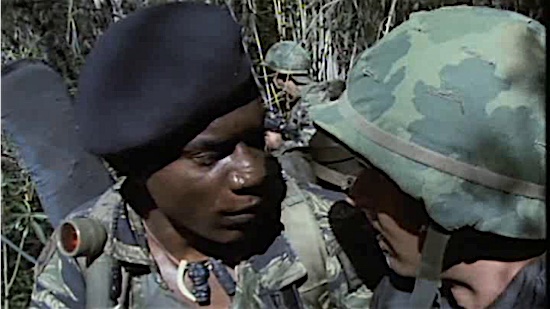
Like many an embedded Vietnam War doc, 84 Charlie MoPic follows a unit of homesick GIs into the jungle, where things subsequently go south, and the ensuing chaos is bottled in the half-heard, half-seen footage captured by the cameraman. Only Patrick Sheane Duncan’s MoPic isn’t a documentary at all, but one of the pioneering examples of the found-footage movie. One sees in it why the subgenre has since become basically exclusive to the horror genre—the idea that we’re watching something shot by the missing (presumed dead) is inherently unsettling and immediately introduces a crucial element of suspense. The story (a Long Range Reconnaissance Patrol scopes out North Vietnamese Army territory) is perfunctory; with 84 Charlie MoPic, a Vietnam vet filmmaker uses the pseudo-doc technique to invoke something like the shuddering fear the soldier on the ground in that war must have felt. —Brogan Morris
97. Hacksaw Ridge (2016)
Director: Mel Gibson
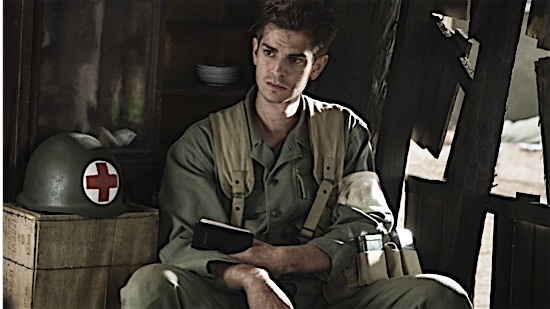
More or less, every film Mel Gibson has made as a director from Braveheart onwards has been a Christian parable with splatter, each one (particularly, obviously, The Passion of the Christ) about a common Chosen One offering himself as a sacrifice for the good of mankind. Gibson’s latest, the schizophrenic WWII drama Hacksaw Ridge—half cornball melodrama, half ultra-violent action movie—is a bloodthirstily reverential bio in the same mould. Its subject, conscientious objector Desmond Doss (played with saintly sincerity by Andrew Garfield), a Seventh-day Adventist who won the Medal of Honor despite never carrying a weapon into combat, might not have approved of Gibson’s gore-hungry style, but the director’s way with battle scenes in the second half of the film is undeniable as cinema. Once it enters the Pacific Theater, and Doss’ regiment sets up camp on the heavily fortified Okinawa, Hacksaw Ridge is all Sturm und Drang, a visceral depiction of war like no other. —Brogan Morris
96. Savior (1998)
Director: Predrag Antonijevic
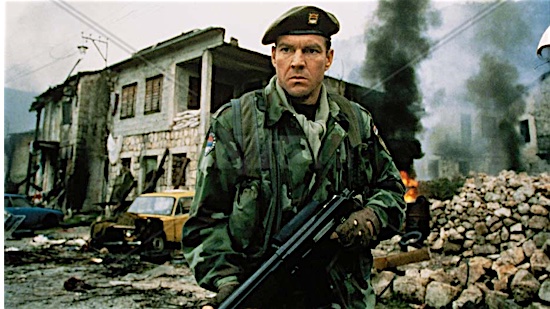
The film begins with our protagonist shooting a group of Muslims at prayer. Unwilling to face justice, this same man then joins the French foreign legion and becomes a mercenary for hire in the Bosnian War of the early-to-mid-’90s. Savior may feature a square-jawed American star in the lead, in the form of a rarely better Dennis Quaid, but director Predrag Antonijevic is keen to establish from the opening scenes that his movie is no Hollywood-ized take on Europe’s last major war (a war which the Serbian Antonijevic saw up close). As he escorts to safety a young woman, pregnant after being raped by enemy soldiers, Quaid’s “Guy” is witness to atrocities that barely make sense in a modern Western setting: smiling children lobbing grenades at unsuspecting infantry; a soldier cutting the finger off an elderly woman’s hand so he can snatch her ring; a humongous Croat executing a line of his former Yugoslav countryfolk, clubbing them over the head with a range of domestic tools. Only in a war like this one, even more senselessly barbaric than his own crime, could someone like Guy find redemption. —Brogan Morris
95. Stalingrad (1993)
Director: Joseph Vilsmaier

One of the most costly battles of the Second World War gets appropriately unflinching treatment in Joseph Vilsmaier’s Stalingrad, a German counterpart to 2001’s Russian sniper drama Enemy at the Gates. From this side, there is no pride wrapped up in fighting Stalin’s great battle—only, initially, complacency and arrogance after the Third Reich has dominated Europe for so long, then later, a gradual, horrifying deflation as the ever-shrinking remnants of Lieutenant Hans von Witzland’s (Thomas Kretschmann) platoon realize the only way they’re leaving the Russian stronghold city is through their own demise. For over two hours, we watch them die in repeated infantry assaults, by sniper fire, in a tank attack, and—eventually, as winter sets in—through illness, starvation, mutinous friendly bullets and the unrelenting cold. By the end, Vilsmaier’s film is a slog, but then it probably shouldn’t be anything else. —Brogan Morris
94. American Sniper (2014)
Director: Clint Eastwood

For some it’s too many caveats, but uncertain politics, historical revisionism and obvious fake baby aside, American Sniper is still one of the very few great fiction films to be made about any of America’s post-9/11 wars. Directed by (the anti-war) Clint Eastwood, the adaptation of the autobiography of deadliest sniper in U.S. history Chris Kyle (Bradley Cooper) is punishingly tense in its Iraq-set battle scenes, the octogenarian filmmaker proving he can still fine-tune an action sequence, and subtly moving whenever it’s back on U.S. soil. It’s in the scenes of quiet Texas domesticity, the sounds of war still playing out as Kyle sits alone at a bar or absent-mindedly watches a blank TV screen at home, that Bradley Cooper emerges as the film’s MVP. He plays Kyle with a sensitivity and restrained anguish that perhaps doesn’t represent who the real Kyle actually was, but whatever the veracity of the depiction, it’s a gently stunning portrait of the emotional paralysis soldiers can suffer upon returning home from an unnatural situation. —Brogan Morris
93. Kelly’s Heroes (1970)
Director: Brian G. Hutton
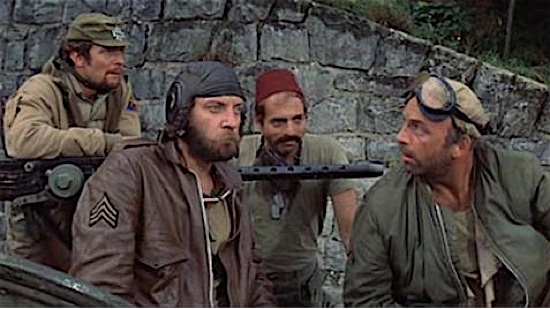
Kelly’s Heroes is a mess of conflicting styles. This daft, odd trifle is a heist movie, a comedy and a western set in WWII-era France, with Clint Eastwood playing a khaki’d Man With No Name, Don Rickles doing his wiseguy shtick and Donald Sutherland acting like he’s time-travelled in from the Summer of Love to play a spaced-out tank commander. All these awkward elements flesh out the bones of a straightforward men-on-a-mission movie, wherein a team of rogues led by Telly Savalas’ sergeant and Eastwood’s laconic Pvt. Kelly carry out the robbery of Nazi gold inside enemy territory. The brash strangeness of the conceit is a big part of why Kelly’s Heroes is so enjoyable—not tied down by anything like realism or tonal consistency, it’s an enthusiastic grab-bag of ideas, with director Brian G. Hutton reveling in destroying his sets like a kid wrecking his playset. It’s a cartoon done live-action, with war as a romp, the backdrop to an escapade without consequences. —Brogan Morris
92. Trial on the Road (1971)
Director: Aleksei German
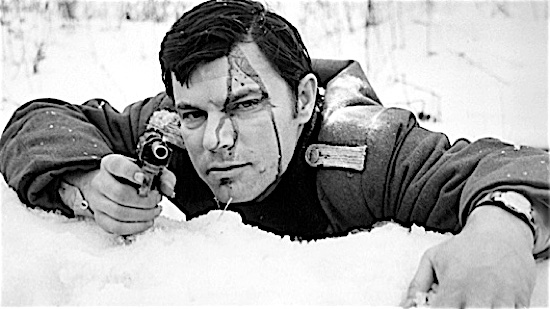
Enfant terrible of Soviet cinema Aleksei German made a hell of an impression with Trial on the Road back in the day—at least with Russian government officials, who were so incensed by his sophomore effort that they banned it for 15 years. Presumably they disliked the harsh tone and wretched violence, as well as the moral gray zone that the film proudly resides in, wherein a Russian who fought for the Nazis under duress might be deserving of and ultimately earn redemption by rejoining the anti-German partisans—all the elements that make Trial on the Road so memorable. It’s a hybrid: a thoughtful and offbeat arthouse film in black-and-white that also has ambitions to be an action movie, led by the inscrutable, Charles Bronson-esque Vladimir Zamansky. It’s gloomy and sad, and ends with a bullet-riddled finale at a German-held trainyard that any Hollywood action director could be proud of. —Brogan Morris
91. Waterloo (1970)
Director: Sergei Bondarchuk

There’s a feast of pre-CGI spectacle on offer in Sergei Bondarchuk’s epic 1970 undertaking Waterloo, which took all the money and might that the Soviet Union and super-producer Dino De Laurentiis together could muster to recreate one of Europe’s most famous skirmishes. Courtesy of Brezhnev’s Russia, the production had at its disposal acres of engineered land and, as extras portraying British, French and Prussian forces, 17,000 of the country’s infantry and cavalry—or, to put it another way, what was said at that time to be the seventh largest army in the world. The film proudly displays its assets in breathtaking widescreen during its chaotic, almost hour-long battle sequence, but still somehow manages to strike a balance between opulent war movie and double character study of two legendary figures. Christopher Plummer plays the Duke of Wellington as a smarmy aristo who enjoys war like a board game, while Rod Steiger is a Napoleon gone to seed, the former military golden boy now an overweight middle-aged man in failing health, showing signs of manic-depression and desperately clinging on to what power he has left as Emperor. —Brogan Morris
90. Restrepo (2010)
Director: Tim Hetherington, Sebastian Junger
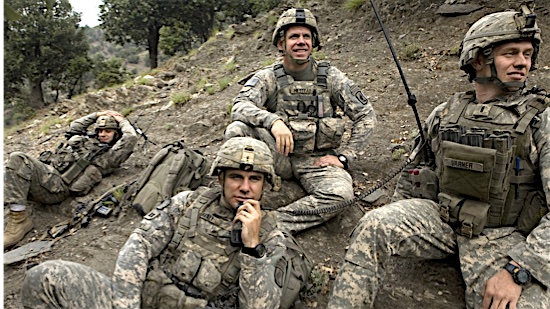
Filmed in Afghanistan’s Korengal Valley during however interminable months it took for a small company of American soldiers to take back inches of that territory from the Taliban and establish the titular outpost, named after their fallen friend, photojournalist Tim Hetherington and journalist Sebastian Junger keep their documentary hyper-focused on the quotidian of the War on Terror. Alternating pointlessly but predictably between long bouts of boredom and spurts of graphic violence, the lives of the soldiers are drained every passing day of all sense of purpose while the lives of both the people of Afghanistan and the Taliban enemy become, more and more, abstractions—to the point that, in a scene following an especially harrowing loss, the soldiers greet a Taliban fighter’s death as one would a villain’s end in a Zack Snyder movie. In Restrepo, death is real until it’s not, the reality of the soldiers’ time in Afghanistan rarely making sense the more they try to accept it. —Dom Sinacola
89. Hamburger Hill (1987)
Director: John Irvin

Flanked as it was by two mega hit Vietnam movies—Oliver Stone’s Oscar darling Platoon and Stanley Kubrick’s acclaimed Full Metal Jacket—1987’s Hamburger Hill had a hard time making an impact. Critics and audiences of the time shrugged, but on reflection the film today seems like a natty forerunner to Black Hawk Down, a no-nonsense, almost apolitical grunt’s-eye view of combat on alien soil. The “why” of the war at ground level matters little to the mostly poor (and disproportionately black) conscripts who make up the American side; as in Black Hawk, the chief concern in the heat of the moment is kill or be killed. Following a brief introduction to a platoon of regular joes, obsessed with music, women and counting the days until the end of service, we watch as heads are blitzed by machine gun fire and bodies disappear from the shock of tree-bound explosives—and all for the sake of capturing a hill of little-to-no strategic value. Platoon argued that “the first casualty of war is innocence.” Hamburger Hill, a meat and potatoes war movie, counters that the only casualties are the unlucky ones who fail to make it out alive, plain and simple. —Brogan Morris
88. Fury (2014)
Director: David Ayer

Rather than portraying the closing days of a conflict (in this case, it’s April 1945, and we’re venturing deep into Germany with the crew of a Sherman tank nicknamed the Fury) as a time to celebrate, David Ayer with miserable expressionist flair presents this as the soldier’s most desperate hour, with exhausted veterans fighting only the fanatical holdouts and attempting to survive what little war is left. Our protagonists’ awareness of their situation in itself makes the picture grueling, a sensation compounded by Ayer’s hard R approach. Fury is one of the most brutal war movies to come out of the studio system, proven in its shocking violence (heads are disappeared by tank shells, German prisoners are beaten until they’re no longer visibly human) but perhaps best exemplified by its quietest scene: the veterans of the Fury, all to varying degrees struggling with PTSD in a time when nobody really understood what that was, regale to newcomer Logan Lerman a story of D-Day horror over dinner. Emotionally battered after three years on the line, we see none of these men quite know how to process what they’ve done, and are all too aware they might never understand “normality” again. —Brogan Morris
87. Sands of Iwo Jima (1949)
Director: Allan Dwan

According to John Wayne’s third wife, after he missed service in WWII (something that regular collaborator and WWII veteran John Ford would subsequently berate the actor for on their sets), Wayne became a “super-patriot,” forever trying to atone for not volunteering. That psychology is obvious from all the unapologetically jingoistic movies Wayne signed up for post-war, one of the finest of which is Allan Dwan’s Sands of Iwo Jima, a star-spangled corker divided up into 40 minutes of training and soldierly bonding, and an hour of booming island combat. As Sgt. Stryker, Wayne plays up his most iconic persona: the hard-drinking and secretly sensitive man’s man, who privately harbors affection for the troops in his command who he’s prepared to pummel to success. The first half, Stryker builds them up; the second half, he one by one watches his boys die, which they always do heroically, their effort essential to the functioning of the colossal American war machine that always continues to roll on through Dwan’s impressively chaotic sets. —Brogan Morris
86. The Beast (1988)
Director: Kevin Reynolds

No exception to the rule that all tank movies must take their crews on gruesome existential journeys, The Beast is an ’80s studio film with a harsh, reflective heart. It looks at the Russian invasion of Afghanistan from the Red side, and proposes that the invasion was not just a fiasco of bad planning and insufficient equipment, but of dwindling patriotism in a Soviet army exhausted by the failing communist state. Directed by Kevin Reynolds, of Waterworld infamy, the film is unsurprisingly offbeat and grungy, but unlike that flop The Beast is no maximalist indulgence. Like George Dzundza—here in the best shape of his career as the titular T-55’s grim commander—The Beast is lean and moody. On a budget, Reynolds offers an eerie atmosphere and some indelible imagery: the crew of “the beast” driving into battle in steampunk-esque war gear; the tank belching out a ring of fire in the night and unwittingly cooking a herd of goat; an Afghan rebel pulverized underneath the tracks of the T-55 into human roadkill. It’s slight, but it lingers. —Brogan Morris
85. Zulu (1964)
Director: Cy Endfield

Every war movie, in adopting the perspective of one side of a conflict as most do, dehumanizes the enemy to an extent. Is Zulu, which begins with a tribal song and dance performed by Zulu extras but later reduces these tribesmen to mindless cannon fodder, guilty of this more than most? The debate will continue over whether or not Cy Endfield’s jingoistic combat film is also innately racist; what’s indisputable is that Endfield’s re-enactment of the defense of Rorke’s Drift by 150 British soldiers from 4,000 Zulu warriors is stirring action cinema. Set almost entirely in a barebones missionary station in the then-British colony of Natal, it’s a single-location movie that makes the utmost of its limitation: the views (of the location’s surrounding South African mountains) are staggering, the battle sequences are frenzied and desperate, and there’s a justifiably star-making performance by Michael Caine, as an effete, entitled officer coming good under pressure. If even potentially offensive filmmaking can still be art, then Zulu must be a minor Brit masterpiece. —Brogan Morris
84. Land and Freedom (1995)
Director: Ken Loach
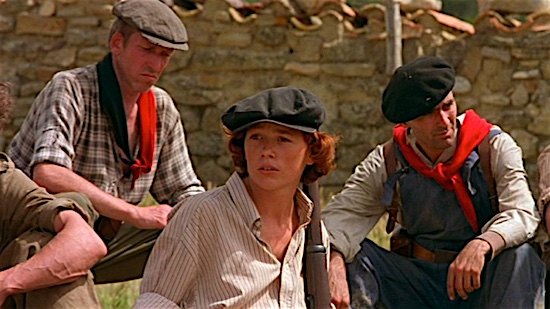
Movies about the American Civil War and Russian revolution abound, but precious few have been made about the Spanish Civil War, a precursor conflict to WWII in which almost half a million were killed in little over two years. Ken Loach’s Land and Freedom might help to explain the dearth of films on the subject: Through the story of David Carr (a magnificently un-starry Ian Hart), a British communist gone to Spain to fight Franco’s fascists, we learn this was no “good war” of clear heroes and villains. David’s story begins romantically in the hazy Spanish hills, liberating small towns with a ragtag collection of anti-Franco fighters, but his idealism is slowly snuffed out by the reality of a complicated fight. The Marxist POUM militia face enemies not just from the right, but from the left and center, from rifle-wielding village priests eager to maintain the status quo and Stalinists determined to crush any socialist factions they consider hostile to the Soviet cause. It’s typically didactic stuff from Loach, who extolls the virtues of socialism while laboring the (fairly obvious) point that fascism and Stalinism are Bad, but the film leaves behind it the evocative whiff of melancholy, for all the hopefuls who find their idealism might not belong in such a complex world. —Brogan Morris
83. A Bridge Too Far (1977)
Director: Richard Attenborough
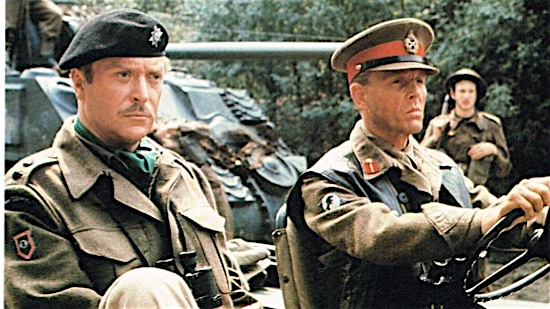
It’s an oddity among WWII movies: a blindingly starry cast and an enormous budget, amassed by director Richard Attenborough to “celebrate” one of the colossal military failures of WWII. The flip side to The Longest Day, A Bridge too Far is the story of how the Allies bet big on winning the war by Christmas, 1944, and subsequently left thousands killed, wounded or captured across the Netherlands. Beginning as adventure, revved up by bally-ho Brits and spunky yanks (including Michael Caine, Elliott Gould and a mighty Edward Fox), Attenborough’s film quickly devolves into a series of glum anecdotes on the futility of war. Anthony Hopkins’ glider troop are met behind enemy lines not by the predicted “old men and kids” but by superior German forces; Robert Redford’s paratroop company are decimated capturing a bridge with leaky boats; and Gene Hackman’s Polish general, dismissively treated by a self-satisfied Allied upper echelon, is forced to watch as his army of free Poles is massacred just as predicted. All the while the German command in Holland, in a strand of black comedy, repeatedly insist the Allies must have secret plans up their sleeve, because they couldn’t possibly be dumb or reckless enough to be attempting what they appear to be. —Brogan Morris
82. Red Cliff (2008)
Director: John Woo
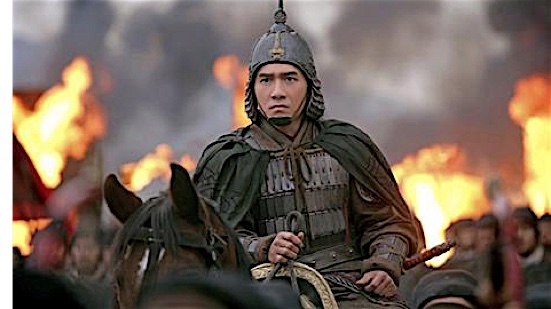
Filming the 2,000-page, 14th-century Chinese novel Romance of the Three Kingdoms is a bit like trying to tell all of Shakespeare’s Henry plays in one movie. There are earth-scorching battles on a massive scale, endless naval armadas crowding the Yangtze River, labyrinthine military strategies, intricate tea ceremonies and a cast large enough to make Robert Altman sweat. The challenges of the source material makes John Woo’s adaptation, retitled Red Cliff, all the more impressive. The film (a five-hour two-parter) may bear little resemblance to Woo’s previous work, but at its core it’s a magnification of his favorite ideas and themes, with bravery and cunning prized above all else, and the line between right and wrong sharply and deeply drawn. Woo also explodes his trademark violence in scale: It’s not just a few cops shooting at each other, but thousands of soldiers attacking with spears, arrows, lances, swords and an array of blunt instruments, the action clear, concise, at times elegant, even as blood splatters across the camera lens. —Stephen M. Deusner
81. Braveheart (1995)
Director: Mel Gibson
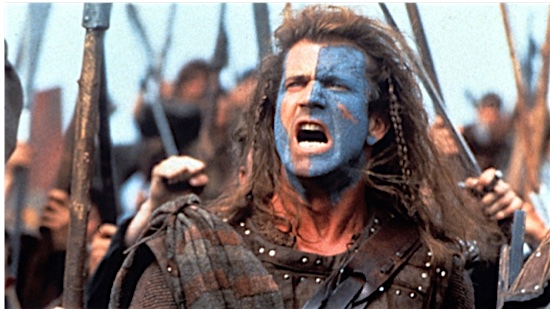
Despite a laundry list of historic “alternative facts,” Mel Gibson’s 1995 Oscar-winning medieval war epic is, unquestionably, one thoroughly stirring cinematic effort. This is due mainly to Scotland itself; John Toll’s cinematography, capturing the lush high and lowlands of the country, is what truly makes Braveheart so memorable—especially juxtaposed against the utter brutality of melee combat. (Gibson is certainly not shy in showing what happens when soldiers take an axe to the gourd.) Story-wise, the liberties taken with the actual events surrounding Scotland’s war for independence do probably make for a more compelling movie—the real William Wallace living in exile in France for years following the Battle of Stirling before his execution would be a tough sell on the big screen. So what that it’s practically an entire fabrication of a real conflict and people? It’s also one hell of an entertaining war movie. —Scott Wold
80. Fixed Bayonets! (1951)
Director: Samuel Fuller
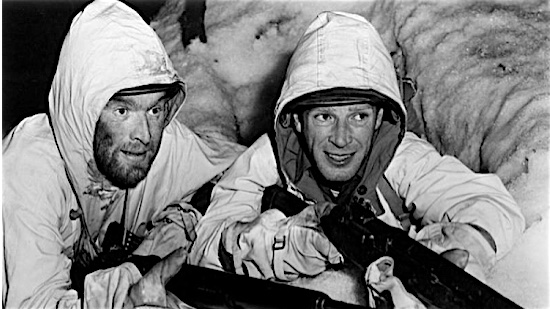
Until he was given something approaching a sizable budget for The Big Red One in 1980, WWII vet Samuel Fuller was forced to tell his war stories with little funding on the tiniest of canvases. Of all Fuller’s B war pictures, Fixed Bayonets! is the smallest—it’s set during the first winter of the Korean War at a U.S.-guarded mountain checkpoint, or quite clearly a small studio lot filled with fake snow—but as with the rest of Fuller’s movies, the filmmaker’s anthropological interest in his characters, sharp action and intelligent social commentary help the film transcend its confines. There are unpredictable, camera-shuddering firefights; there are excruciating trips through a minefield; there’s the growing tension of a responsibility-averse corporal (Richard Basehart) falling up the chain of command as his superiors are offed one by one by the enemy. It’s a cheap film with more brains and excitement than most movies made for 20 times the money. —Brogan Morris
79. Casualties of War (1989)
Director: Brian De Palma
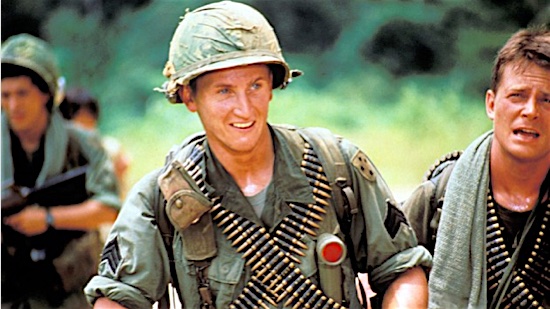
Take a true-life story of a group of GIs kidnapping, raping and murdering a village girl at the height of the Vietnam War, then re-tell it via the effortless popcorn style of Brian De Palma, and what’s left still can’t help but be a nasty film about a supremely nasty incident. That De Palma’s filmmaking remains typically showy even here makes Casualties of War a queasier ride than it would be minus the flash, and the director makes some questionable decisions in adaptation, like turning the murder into a thrilling action sequence and conjuring up an out-of-sync happy ending. Whatever missteps the film makes, Casualties is still overwhelmingly, unshakably shocking. Not simply a look at just how warped ’Nam got for innocent Vietnamese bystanders and for dangerously desensitized Americans, the film is also a lesson in toxic social psychology, with Michael J. Fox’s meek private attempting to talk his comrades out of their would-be crime, and being out-argued by a repulsively charismatic Sean Penn every step of the way. —Brogan Morris
78. They Were Expendable (1945)
Director: John Ford
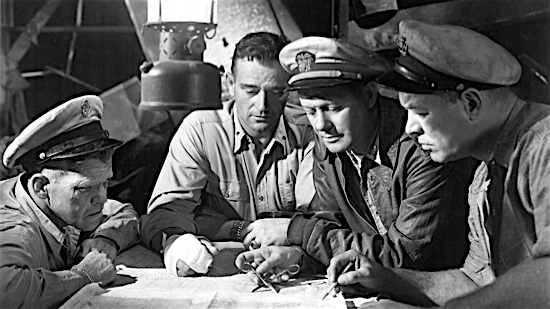
From the opening credits, which includes military rank alongside names, it’s clear how They Were Expendable has the edge on most war movies. Actor Robert Montgomery, an officer in the U.S. Navy during the D-Day landings, plays the resilient PT boat commander hero; Frank Wead, a naval veteran of both the First and Second World Wars, writes; and John Ford, wounded at the Battle of Midway whilst making one of his many documentaries for the war department, directs. Such direct experience makes for a film about the war at sea that was about as realistic as one could get from Hollywood in 1945. The combat scenes are spectacular, propulsive sea battles shot out in the waters of the Florida Keys, but Ford has more time for exploring the psyches of his characters. As his lieutenant delivers a eulogy for a fallen comrade, even John Wayne proves himself capable of some real emotional heavy lifting. —Brogan Morris
77. Letters from Iwo Jima (2006)
Director: Clint Eastwood
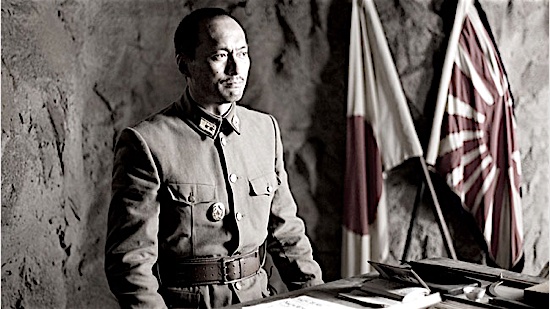
In 2006, Clint Eastwood released two war movies, one entirely expected—Flags of Our Fathers, the soggy, corn-fed story behind the iconic raising of the American flag at the battle of Iwo Jima—and another that didn’t read like an Eastwood pic at all. Letters From Iwo Jima is a humanist Japanese-language drama about that battle’s losing side, set largely during the buildup to attack, taken from the perspective of the sensitive Japanese general running the show (an extraordinary Ken Watanabe). And so a filmmaker so closely associated with American stories made one of the great Japanese war movies, closer to meditative Japanese cinema than to his own usual style, and near entrancing in its depiction of soldiers ritualistically preparing for an invasion they know will end in their deaths. With everything bathed in a green-and-tan sepia, Eastwood’s martyrs poignantly already look like long-gone relics. So long the faceless villains in Hollywood’s movies about the Pacific Theater, Eastwood contends that the Japanese grunts of WWII hated Iwo Jima, feared dying and had their own banal life concerns just like the soldiers on the other side. —Brogan Morris
76. The Sun (2005)
Director: Aleksandr Sokurov

An unofficial companion piece to Downfall, Oliver Hirschbiegel’s recreation of Hitler’s final days in his Berlin bunker, Alexander Sokurov’s The Sun offers a woozy snapshot of the pampered, odd, lonely life of Emperor Hirohito as WWII comes to a close for Japan. It’s a war film in which we see no actual war, only the aftermath, when Hirohito is finally escorted from his own bunker through a bombed-out Tokyo to discuss peace with General MacArthur. Until then, we only hear bombs falling outside the fortified palace where Hirohito writes poetry, conducts scientific research and ponders out loud why he was urged to back a likely unwinnable war in the first place. Slow and surreal, The Sun is less accessible than its German counterpart, though it matches Hirschbiegel’s film for the quality of leading man. Issei Ogata gives an astonishing performance as Hirohito, painting a portrait of someone turned eccentric by years of isolation and coddling, a “living god” whom the occupying American forces come to regard as though some rare bird. In one scene, U.S. soldiers take photos of Hirohito during one of his infrequent public appearances. The soon-to-be abdicated Emperor, child-like, responds to requests for poses by putting on a Chaplin-esque show. —Brogan Morris
75. Che (2008)
Director: Steven Soderbergh
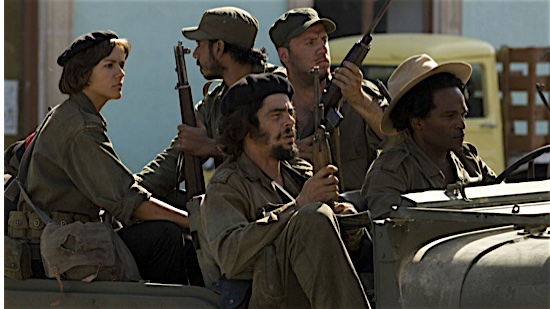
Steven Soderbergh’s “biopic” of Che Guevara, actually a double bill of films centered on two of the revolutionary’s military campaigns—the one that made his name and the one that would claim his life—is a story of guerrilla warfare in two parts. Part one, The Argentine, is a rousing, lushly colorful account of the Cuban revolution, and part two, Guerilla, a somber, handheld take on the doomed Bolivian “revolution” of 1967. The former is a story of the soldier in victory, with the scrappy July 26th Movement winning clashes against government forces, while the latter—originally a Terrence Malick project—is a treatise on death, a grim tale of idealism broken on the dusty slopes of Bolivia, as Guevara and an ever-dwindling band of combatants are picked off by CIA-backed anti-insurgency troops. Benicio Del Toro towers over the project as rebellion’s poster boy, while Soderbergh’s depiction of combat is almost anti-cinematic: confused, drawn-out and fundamentally inglorious. —Brogan Morris
74. A Walk in the Sun (1945)
Director: Lewis Milestone

“Seems like this war is nothing but waiting,” intones narrator Burgess Meredith early in Lewis Milestone’s understated WWII drama A Walk in the Sun. The waiting is what the film emphasizes: the long, dull moments that come in between the action sequences most war movies savor. Any fighting that happens in Milestone’s movie is brief, or takes place off-screen, heard in the distance or discussed as hearsay by bored servicemen men. The antithesis to all that was thought to make a war movie in 1945, A Walk in the Sun’s speciality is inaction. The entertainment instead comes from jocular exchanges about home or inedible military chow that the men of the 36th Infantry, like Lloyd Bridges’ affable Sgt. Ward and Richard Conte’s chain-smoking smart-mouth Rivera, use to pass the time on their cross-country invasion trek through rural Italy. An hour and a half of waiting is enough to lull the viewer into a false sense of security before suddenly a final battle finds enormous expense for negligible gain, a sacrifice from the “Texas Division” for an objective so insignificant it would not even make the history books. —Brogan Morris
73. The Last of the Mohicans (1992)
Director: Michael Mann
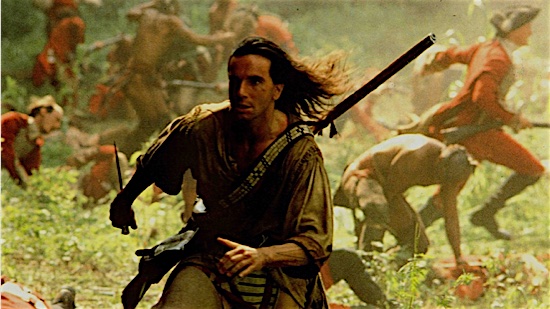
On one of his many jaunts through American history, Daniel Day-Lewis stops off in 1757 in the middle of the French and Indian War in Michael Mann’s The Last of the Mohicans, playing a white man raised by a Native American chieftain and beholden to no one side in the fight engulfing the then-British colony of New York. Mann does not delve too deeply into the tangled politics of this particular American war, instead focusing on the general antagonism felt by American Indians towards white colonists—whether French or British, Europeans scrap for land that never belonged to them in the first place—and their perpetual thirst for conflict. The romance between Day-Lewis’ Nathaniel Hawkeye and Madeleine Stowe’s English debutante Cora Munro may be tepid, but typical for Mann the action is marvelously arranged, from the explosive siege at Fort Henry (first spied from a distance as a storm of fire in the night, just one of many spellbinding images courtesy of DoP Dante Spinotti) to the rousing, emotionally charged showdown between the last Mohicans and a rival tribe led by a glowering, damaged Wes Studi. —Brogan Morris
72. Ride with the Devil (1999)
Director: Ang Lee
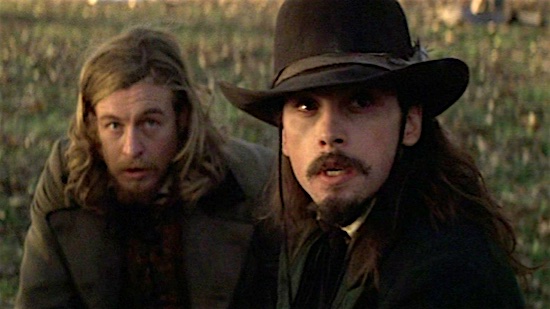
Unlike so many Civil War movies taken from the Confederate side (see Gettysburg from six years prior, or Anthony Minghella’s Cold Mountain, which arrived four years later), Ride with the Devil doesn’t shy away from the racial factor which played such a crucial part. Ang Lee’s bushwhackers—gentlemanly guerrillas played by blandly pretty actors like Tobey Maguire and Skeet Ulrich—are racists, as well as cold-blooded murderers. It has realistically clumsy action and painterly scenery, but a major part of the appeal of Devil is that it takes a complicated view of a mythologized war and its combatants. Lee’s mastery of character is present and correct right along with his fascination with one of his specific American milieus—its sociopolitical layers, its language (oh how James Schamus writes that florid southern dialogue) and its topography, lensed with quiet admiration by cinematographer Frederick Elmes. There’s a love triangle between the characters played by Maguire, Ulrich and Jewel (it can be an oh-so-’90s movie at times), but the real love story is between Maguire’s German-born idealist Roedel and Jeffrey Wright’s free black Holt, two men who form a bond fighting for a country that often doesn’t even consider them its own. —Brogan Morris
71. Lebanon (2009)
Director: Samuel Maoz
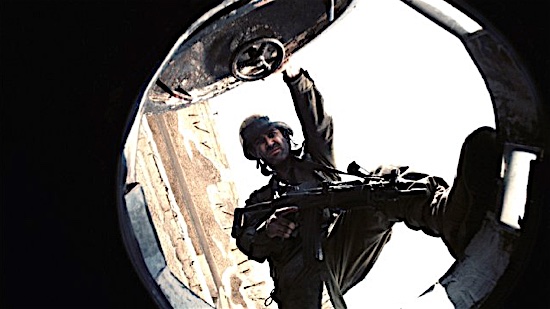
So eerie and humming with dread it could almost be a horror film, Samuel Maoz’s Lebanon, based on the director’s own experiences as a gunner for the Israeli tank corps during the 1982 Lebanon War, uses budgetary shortcomings to its distinct advantage. Maoz makes the Das Boot of tank movies, a sweaty, intensely claustrophobic film where the viewer hunches inside a creaking war machine for almost the entire run time. We, like the inhabitants of the tank, see outside the vehicle only via its gunsight. Whether they’re viewing the remains of a recently besieged town or the screaming, de-limbed torso of a Lebanese civilian whose truck they’ve just shelled, the crew remains always at a curious distance from the conflict. From their perspective, war is hell through a periscope lens, both frightening and unfathomable. —Brogan Morris
70. Inglourious Basterds (2009)
Director: Quentin Tarantino
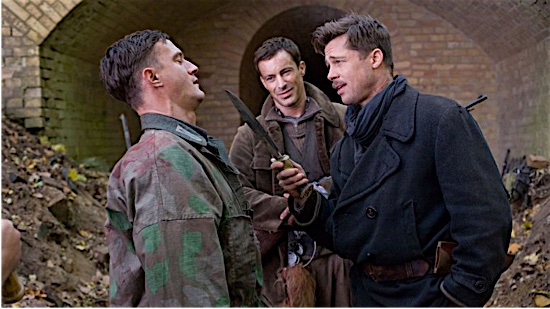
Quentin Tarantino’s dual loves of vengeance and cinema have never had a purer expression than the face of a Jewish cinematheque owner projected Oz-like onto the smoke of Nazis aflame. The story goes like this: In the middle of the war, propagandist Joseph Goebbels plans to screen his latest pro-Nazi film for the party’s elite at a small Parisian theatre that is, unbeknownst to Goebbels, run by Shosanna Dreyfus (Melanie Laurent)—whose family was killed by SS officer Hans Landa (Christoph Waltz, evil incarnate with a gentleman’s face), and who is working in collaboration with American Aldo Raine (Brad Pitt) and his squad of Nazi-scalping Jewish soldiers. To an almost touching degree, Inglourious Basterds recognizes that the vengeance driving so many films—and certainly Tarantino’s own—is a cinematic impulse, a fantasy of light and sound, cleanly separated from common sense and actual history. It’s flippant, but in Tarantino’s low-rent, pulpy way, Basterds celebrates the well-known cases of Jewish resistance. —Robert Davis
69. Jarhead (2005)
Director: Sam Mendes
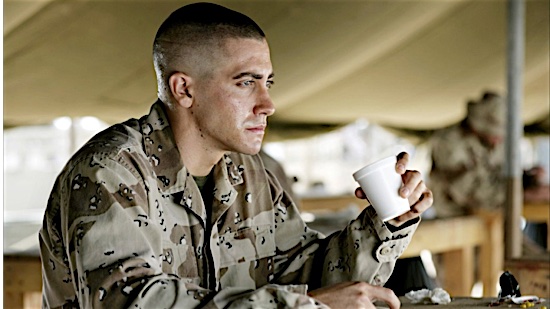
What perversity, to make a war film all about people waiting for a chance to fight in a war and never getting a chance to actually do it. That’s Jarhead, Sam Mendes’s adaptation of Anthony Swofford’s 2003 memoir about his experiences during the first Gulf War. But considering that that initial middle-Eastern conflict turned out to be mostly fought in the air and through media airwaves, how else to be true to Swofford’s wartime experience? That perhaps makes this film more conceptually interesting than compelling to actually watch; nevertheless, there is a thematic and structural integrity to this film that is admirable in the abstract. If Jarhead adds up to anything resonant, it’s as a feature-length meta-commentary on other war movies. Seeing a whole room of soldiers cheering the ostensibly horrifying destruction orgy set to Wagner’s “Ride of the Valkyries” in Francis Ford Coppola’s Apocalypse Now, one can’t help but be reminded of François Truffaut’s famous skepticism that war movies could be anything but pro-war, however unintentional on a filmmaker’s part. Mendes’s film takes that sentiment to a deliberately frustrating yet utterly logical extreme: Jarhead is a war movie that leaves no one—neither viewers who get off on depiction of wartime combat nor those who demand a confirmation of their anti-war biases—satisfied. —Kenji Fujishima
68. The Blue Max (1966)
Director: John Guillermin
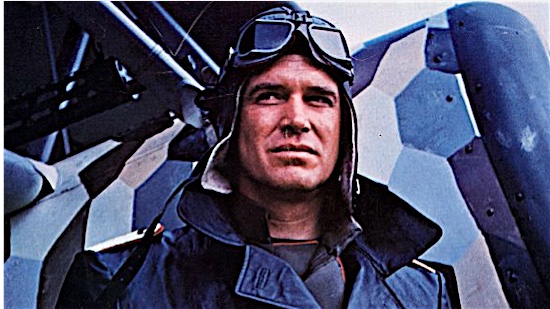
“There’s something of the cobra in you.” That’s how Jeremy Kemp’s WWI flying ace von Klugermann greets greenhorn pilot and soon-to-be rival Bruno Stachel, who outwardly may have the prim dash of a golden-haired George Peppard, but is in actuality a smirking, entitled psychopath determined to bag the German air force’s top medal: the Blue Max, a prize for downing 20 enemy craft. To Stachel, all else is immaterial—he’ll slaughter unarmed enemies and even betray his own to win the ribbon and silence the high-born comrades who mock his commonality. Bear with the redundant romance between Stachel and Ursula Andress’ Countess; there are few better films about war in the air, and rarely do we get to see the war movie’s hero acting so thoroughly unheroic, fighting not for patriotism, but for a chance to claim superiority among his peers. The aerial sequences are the highlight, pre-CG dogfights shot with real clarity, though on the ground there’s also a fascinating glimpse of an alternative WWI: behind the mud-swamped trenches, in plush manor houses filled with champagne, the air aces live like aristocracy. —Brogan Morris
67. Overlord (1975)
Director: Stuart Cooper
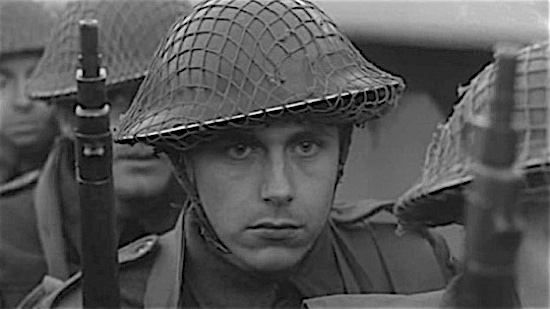
How can something so meager possess such power? Dirty Dozen cast member-turned-writer/director Stuart Cooper fills the budget-necessitated holes of British WWII drama Overlord with copious archive footage, to tell the story of a Brit draftee named Tommy (what else?). Put through military training in preparation for D-Day, Tommy and his fellow soldiers suspect they’ll be killed almost instantly. Before his departure for Normandy, Tommy briefly woos a girl, only to be haunted by the possibilities were it not for a war he’s reluctant to fight. Bolstering the fiction filmmaking with documentary footage achieves some mesmerizing effect here—rather than cheapen the film by highlighting its budgetary shortcomings, the decision to include archival material retains a vital tie to the past. The film basically plays one sustained note about the death of innocence, but Cooper chooses the perfect chord. —Brogan Morris
66. Von Ryan’s Express (1965)
Director: Mark Robson
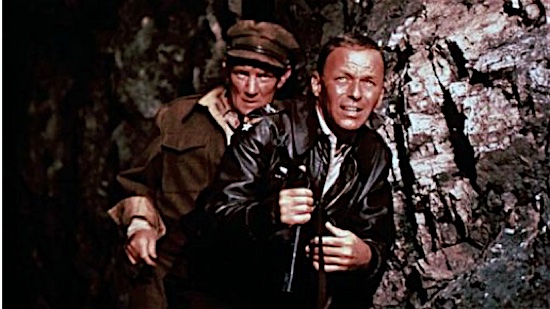
Pearl Harbor melodrama From Here to Eternity revealed his humanity, but the laidback star quality of Frank Sinatra as actor was captured arguably nowhere better than Von Ryan’s Express. The swagger of Ol’ Blue Eyes is the driving force behind Mark Robson’s prison escape drama-cum-men on a mission movie, wherein Sinatra’s captured flight officer and his flock of Allied POWs commandeer a German prison train to escape from Italy into neutral Switzerland. It’s fights atop speeding trains, rocket-flinging air assaults and Allied soldiers nervously masquerading as German officers through Nazi-held checkpoints, as “Von Ryan’s Express” hurtles through picture-postcard Italy—all adding up to a thrilling caper, but for the last minute rug-pull that adds an unexpected, thudding pathos. Von Ryan’s Express is one example of a book-to-screen adaptation where Hollywood made the movie darker: in the screen version, the happy ending of the novel which Robson has been building towards for almost two hours is cruelly snatched away from us just as the credits are about to roll. —Brogan Morris
65. Air Force (1943)
Director: Howard Hawks
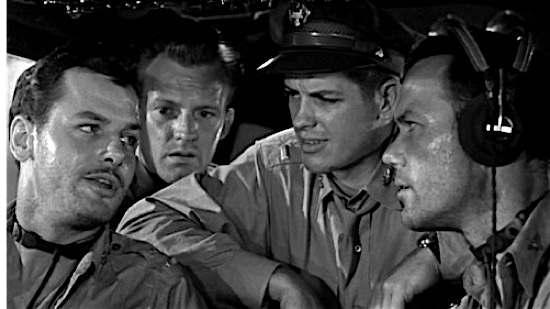
Made—like so many Hollywood war films of the time—to bolster support for the war and inform the American public just what their tax dollars were paying for, Air Force bears the obvious hallmarks of propaganda: uncritical portrayal of the American war machine, tales of gallant sacrifice, dehumanization of the enemy that occasionally tips over into racism. What sets Air Force apart and keeps it vital is the way it keenly puts the viewer in the place of a U.S. airman, despite it being an almost entirely studio-bound enterprise. Once in the air, instead of a score we hear the constant hum of the flight, and the mundane, repetitive exchanges of the crew. In the confusion of the immediate aftermath of Pearl Harbor, there’s teamwork between island-hopping strangers, in rousing, hectic battle sequences on land and in the air, in the USAF and Marines together rebuilding damaged airplanes as all the while Japanese forces approach. The point for audiences at the time was supposed to be that the U.S. Forces worked as a well-oiled unit, but the film’s message doubles as a comment on man as a durable social animal, cooperating even in the harshest of circumstances in order to ensure survival of the tribe. —Brogan Morris
64. Sergeant York (1941)
Director: Howard Hawks
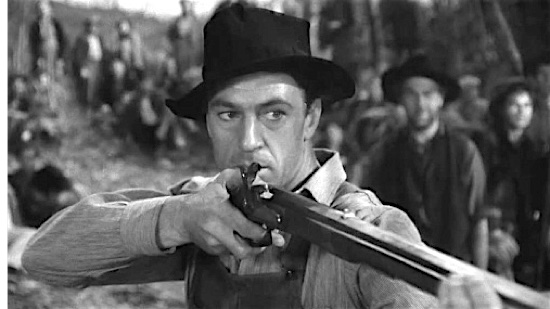
Howard Hawks’ Academy-Award-winning Sergeant York, starring Gary Cooper, follows the story of a hell-raising conscientious objector who became one of the most decorated American soldiers of the Great War. York is a masterpiece, a parable about a sticks sharpshooter dead set against slaughter: how a poor Tennessee farmer found marriage, religion, and a cause, in that order. It provides much more food for thought than you’d expect from a movie made on the eve of Pearl Harbor. There’s a surprising amount of characterization and shading for a depiction of life during wartime: York kills, even though he does not want to. Though fictionalized in parts, the Hawks-Cooper two-man show does not play false with any part of Alvin York’s journey. In its own way, York tells us what soldiers have always known: the war is also fought within, as well as without. —Jason Rhode
63. Attack! (1956)
Director: Robert Aldrich
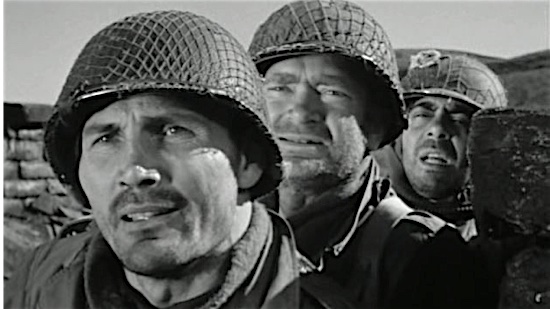
If so many of the glut of war movies made in the post-war period have failed to stand the test of time, it could be that the unrealistic moral monochromia and lack of psychological insight of many ring false in a world that views complexity as a given in its war movies. Robert Aldrich’s Attack! is one that’s survived—and in fact flourished, since it opened to mediocre box office in 1956—because, were it not for the black-and-white boxy image and the presence of some of the most memorably salty actors of the day, it’s grown up and sophisticated enough that one could think it had been produced yesterday. James Poe’s dialogue-thick screenplay has little time for histrionics or heroics, focusing instead on the tussle between Eddie Albert’s inept company commander and Jack Palance’s headstrong platoon leader, the latter determined to get revenge on his insecure CO for repeatedly ordering his men to their deaths. Made at a time when John Wayne was still storming beaches with his uniformly loyal and capable grunts, Attack! posits that some, no matter the training, will always be just plain unprepared for combat—and that politics in war can be a shady, callous affair. —Brogan Morris
62. City of Life and Death (2009)
Director: Lu Chuan
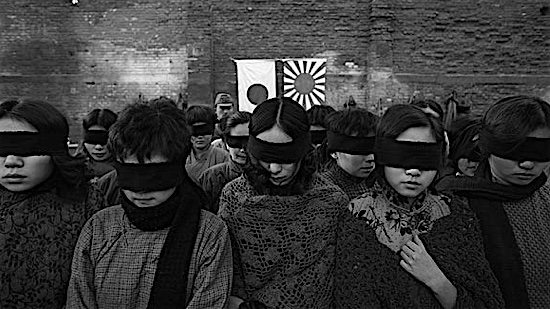
Most movies get made because their creators wanted to make them. Then there are movies such as City of Life and Death, which one feels simply had to be made—for education, for posterity, for mere perspective. Lu Chuan’s film is a stressful, appropriately black-and-white depiction of the 1937 Rape of Nanking, an approximately six-week “incident” in which between 40,000 and 300,000 Chinese civilians and prisoners-of-war were killed by occupying Japanese forces in the former Chinese capital. The film’s imagery is cruel to the viewer, right down to its starvation of color. Sometimes the film’s a moving Bruegel painting, each shot a tangle of bodies and rubble, with every character destined for death at worst or prolonged mental and physical torture at best. Lu begins with muscular battle scenes, then moves on to unflinching misery as occupation begins, with machine gun execution by the thousands, live burials, death by rape—human annihilation. It’s cinema as a monument, a reminder inscribed: never forget, never repeat. —Brogan Morris
61. Glory (1989)
Director: Edward Zwick
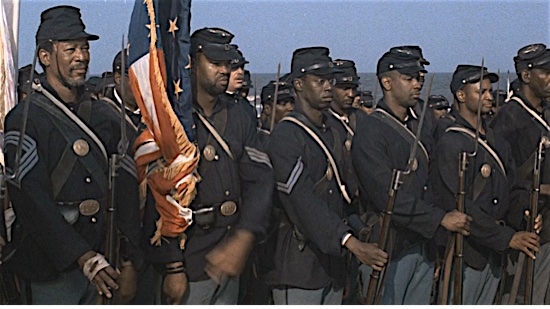
Matthew Broderick may appear in the lead as Col. Robert Gould Shaw, but Glory belongs to Denzel Washington (Pvt. Trip), Morgan Freeman (Sgt. Maj. John Rawlins), Andre Braugher (Cpl. Thomas Searles) and Jhimi Kennedy (Pvt. Jupiter Sharts). These actors deliver incredible performances as members of the first all-black regiment in the Union army, during the Civil War, with Washington going on to win the 1990 Oscar for Best Supporting Actor. Instead of focusing on the obvious North vs. South binary, Glory follows the men as they struggle against Northern racism and their own perceptions of what it means to be black, and what it means to be black in an army where they are almost never seen as equals—despite fighting on the same “side” as their white counterparts. With a hauntingly beautiful score, and some of the most memorable war scenes directed by Edward Zwick, Glory is one of the most important films not just about the Civil War, but about America’s eternally complicated history of racism and the black pride that persists in spite, on the battlefield and beyond. —Shannon M. Houston
60. Rescue Dawn (2006)
Director: Werner Herzog

As PG-13 as a war movie can get, Werner Herzog’s cinematic re-creation of his own documentary (Little Dieter Needs to Fly) feels as if, like any Herzog film can, it was re-created on the fly. Rescue Dawn avoids a strict adherence to the truth of Dieter Dengler’s ordeal, in which he served as a pilot for the U.S. Navy during the Vietnam War, shot down over Laos then captured and tortured for months before escaping. It’s also historically inaccurate, as only any Herzog film can be, for the benefit of the more “ecstatic” truth the director was attempting to reach, ignoring the complaints of Dengler’s fellow prisoners’ accounts, which mostly have to do with how heroically Herzog portrays Dengler (Christian Bale) and how pathetically he imagines the others. Herzog saw himself in the real Dengler anyway—they were both born poor in Hitler’s Germany—and Bale seems to intuit the director’s projection, playing Dengler as an endlessly fascinating hybrid of wide-eyed innocent and arrogant American, fully committed to the freedom and opportunities for self-aggrandizement that being an American affords. And yet, Rescue Dawn doesn’t defend Dengler’s patriotism, or really have anything poignant to offer about American’s checkered military past. Instead, Herzog is concerned as ever with the tyranny of Nature and all powers like it, which happen to include war, America, the ambition of Man, whatever—an idealistic guy like Dieter Dengler can only suffer, survive and then tell his story later to a director who will warp its facts to keep the true extent of the man’s suffering from the cold, calculating judgment of the MPAA. —Dom Sinacola
59. The Steel Helmet (1951)
Director: Samuel Fuller

“It dares tell the TRUTH behind today’s headlines!” yelled the poster banner for Sam Fuller’s first war film, and while the proclamation sounds sensationalist, the director was determined to speak truth to power at any cost. Making the first film about the Korean War while the conflict still raged, Fuller used his yarn, about a rag-tag group of dogfaces in a showdown at a Buddhist temple to take a critical look at America’s domestic affairs: a black soldier ruminates on why he goes to war for a country where he is regarded as a second class citizen while a Korean POW comments on America’s internment of Japanese citizens in WWII. As Sergeant Zack, future Fuller stalwart Gene Evans (cast by the director above studio favorite John Wayne) is the first in a long line of grizzled military anti-heroes carved straight out of Fuller’s own wartime experience. When Zack shoots a prisoner in cold blood, this earned Fuller the ire of the military brass. They couldn’t accept this as an actuality, to which the iconoclastic veteran and filmmaker replied: “It happens! I fought a war. Things like that happen! And you know it!” —Liam Dunn
58. The Red Badge of Courage (1951)
Director: John Huston
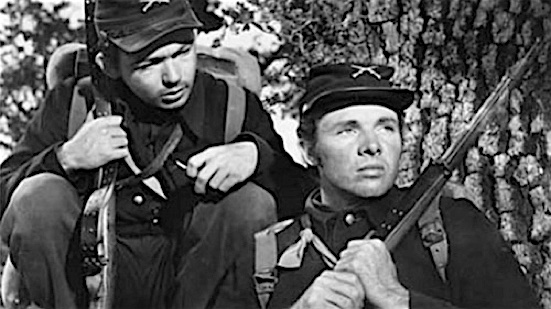
In a rare example of a film surviving studio butchery with value and some auteurial vision intact, The Red Badge of Courage in its only viewable form—a studio-mandated 69-minute cut, with director John Huston’s own 95-minute version long thought lost—may be a sketch of the director’s original intent, but it’s still a substantial one. An adaptation of Stephen Crane’s Civil War novel, noted for its realism, Red Badge casts actual WWII hero Audie Murphy as Union trooper Henry Fleming, who flees from his first skirmish only to later seek redemption through recklessness on the battlefield. Huston’s noir-ish touches lend a despairing claustrophobia to an already despairing tale; Crane’s is a deeply unromantic war story, where proving one’s “courage” means shedding blood, and the natural instinct to fly from a slaughter is considered cowardice. Huston’s longer cut promised more fleshed-out portrayals of Henry’s platoon mates, but the film in its abbreviated form might actually be at an advantage: in keeping the other characters as ciphers, the movie heightens Henry’s isolation and makes an unintentional point about the soldiers in the bloodiest war fought on American soil being treated not as individuals, but pure, anonymous cannon fodder. —Brogan Morris
57. Stalag 17 (1953)
Director: Billy Wilder
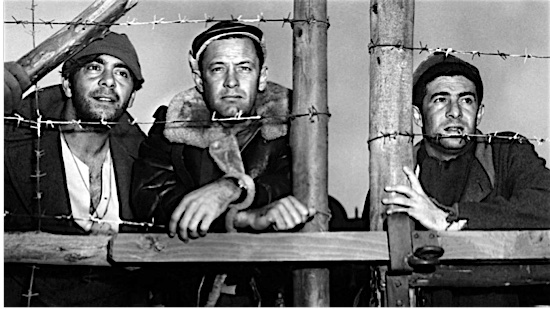
Tonally, Billy Wilder’s prisoners of war story is a true dramedy, fitting into an odd post-war space when American cinemagoers were apparently content to laugh at the horrors faced by prisoners, even while being reminded of the deadly results of incarceration, which were obviously even more dire for victims of the Holocaust. It’s William Holden who makes the film click and hum, portraying American airman Sefton as a somewhat sleazy but clever profiteer who figures that if he’s going to spend time in a POW camp, he might as well be an enterprising big shot while he’s there, living as comfortably as he can. In comparison with a film like The Great Escape, which would later come along and tell a story ringing with many of the same tropes, albeit without the screwball sense of humor, Stalag 17 is both an escape story and a light mystery, centered around the identity of the German informant who is sabotaging each attempt by the Americans to flee the camp and defy the Germans. With a cast of colorful characters and good-natured humor, Stalag 17 somehow takes a horrific premise and mines it for laughs more successfully than one would have thought possible. —Jim Vorel
56. Gallipoli (1981)
Director: Peter Weir
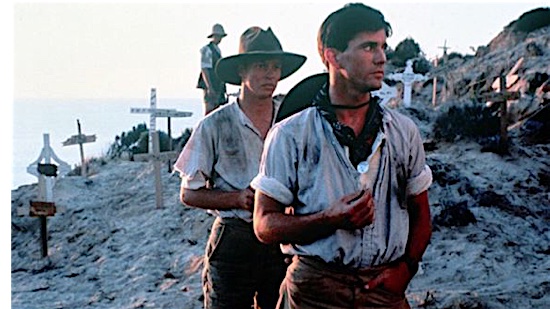
Director Peter Weir has always been a master heartstring-puller; whatever his subject matter, he takes a very emotion-forward approach. That said, please understand that Gallipoli will not tug at your heart: It will flat out break it. A group of young men from rural Australia enlist in the Army during WWI and are sent to the Gallipoli peninsula in present-day Turkey to participate in the campaign that culminates in the tragic Battle of the Nek in 1915. This is a story about idealistic young men-primarily Archie Hamilton (Mike Lee) and Frank Dunne (Mel Gibson) losing their innocence about the real meanings and purposes of war. It’s a dissertation on futility and senselessness and no, there is not a happy ending. It’s also, like many films of the Australian New Wave, a coming-of-age story about Australia itself—a depiction of a young country trying to understand its identity. Weir’s always been a master at creating sympathetic characters whom we bond with as they bond with each other. In this film that emotional investment cruelly underlines the devastation of war. —Amy Glynn
55. Run Silent, Run Deep (1958)
Director: Robert Wise
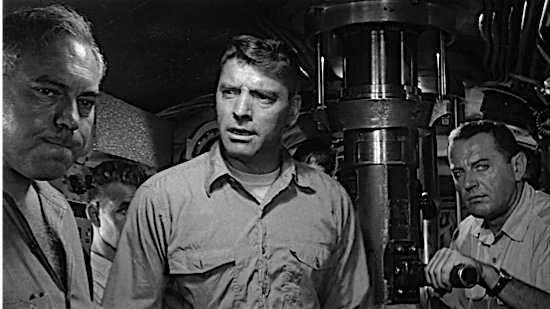
Captain Ahab and his elusive prize both get a WWII makeover in Run Silent, Run Deep, Robert Wise’s Pacific Theater thriller in which Commander Richardson (Clark Gable) of the USS Nerka mercilessly hunts the Japanese destroyer that sank his old vessel and killed his crew. All the while, the more interesting rivalry is happening within the American sub, where Richardson has to contend with his ambitious younger XO Bledsoe (Burt Lancaster), in a reflection of the very real discord between fading star Gable and Lancaster. Off-screen struggle proved grimly advantageous: Gable, then a chronic alcoholic, delivers a suitably exhausted performance as the obsessed Richardson, while the clash of egos between Gable and Lancaster seeps into the power balance enmity between their characters. Some of Run Silent’s then-state of the art miniature effects may have dated, but the ocean-bound battle scenes still have a tactility that no modern CGI can match. Scenes of enemy torpedoes or depth charges narrowly sailing by the Nerka pass in agonizing silence, as Wise cranks up the tension inside Richardson’s compressed tin can with a close, anxious realism. —Brogan Morris
54. The Wind that Shakes the Barley (2006)
Director: Ken Loach

A tale of two wars in Ken Loach’s Palme d’Or winning The Wind That Shakes the Barley, an Irish counterpart to Loach’s own Land and Freedom. Once again, the initial purity of the revolution gives way to the reality of complicated regional politics, opportunistic power grabbing and divisions of opinion, the “successful” Irish independence struggle immediately segueing into the 1922 – ’23 Civil War that pitched formerly united friends and family against one another. There’s a nastiness and total lack of light that separates Barley from the director’s other works. British soldiers and Irish rebels, having dehumanized the other side, torture and kill with glee, while later the anti-treaty IRA (represented by Cillian Murphy and Liam Cunningham, incredible) and pro-treaty Irish Army having come so far kill their own countrymen in absolutist determination. The evergreen County Cork period setting makes this one of Loach’s more aesthetically pleasing features, but the tale and the tone make it one of his more heart-wrenching and fatalistic. —Brogan Morris
53. Hell in the Pacific (1968)
Director: John Boorman

Just a year after he’d captured Lee Marvin at his most mythic in Nouvelle-noir classic Point Blank, John Boorman teamed up with Marvin again to present the granite-hewn star at his most human. Here, in Boorman’s spare survival drama, Marvin is a stubborn U.S. airman forced to cohabit with a Japanese naval officer (Toshiro Mifune, in a performance that’s by turns playful and stoic, defeated and triumphant) when the pair find themselves stranded on a desert island at the height of WWII. Said to be privately Marvin’s favorite of his own works, it’s a film that reflects the anti-war stance of its two veteran stars. As the situation of Marvin and Mifune’s unnamed pair becomes desperate, their hair growing wild and their clothes increasingly ragged, and they come to rely on one another to survive (without ever breaching the language barrier, and there are no subtitles to aid us either), Boorman emphasizes that the two soldiers’ initial shared disdain is based only on the fact that they occupy two artificially different “sides” of a conflict. It’s summed up in the tragicomic line Marvin delivers to Mifune late in the film, upon being spooked by his friend’s sudden appearance: “Oh—for a second I thought you were a Jap.” —Brogan Morris
52. Kingdom of Heaven (2005)
Director: Ridley Scott
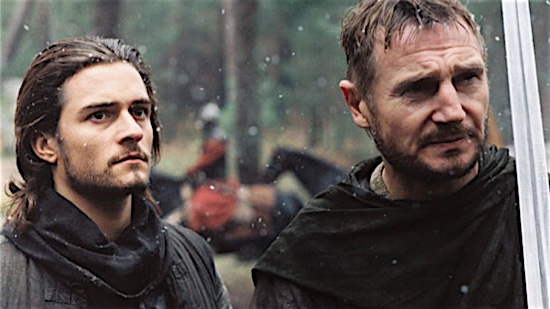
It’s mystifying that such a core component of a film could be so unmistakably off—in this case, a reliably flat Orlando Bloom, in the lead role of blacksmith-turned-crusader Balian—and still not spoil the overall product. The rest of Ridley Scott’s Crusades epic is so dazzling, so riveting thematically and so loaded with acting dynamos (Eva Green, Liam Neeson, Edward Norton, Jeremy Irons, Brendan Gleeson, Michael Sheen…) that it engrosses absolutely. Visually Kingdom of Heaven is one of Scott’s finest feasts, the maestro voraciously capturing an ancient world in eager widescreen, but the film stacks up even better as food for thought. Amidst the borderline schlocky battle scenes and Middle-Eastern politics, Scott and screenwriter William Monahan ask big questions about faith, class and destiny that somehow strongly resonate some 800-plus years on from when their story takes place. The film’s hacked-up theatrical cut was dismissed in 2005; its director’s cut should now be reclaimed as a modern great. —Brogan Morris
51. Salvador (1986)
Director: Oliver Stone
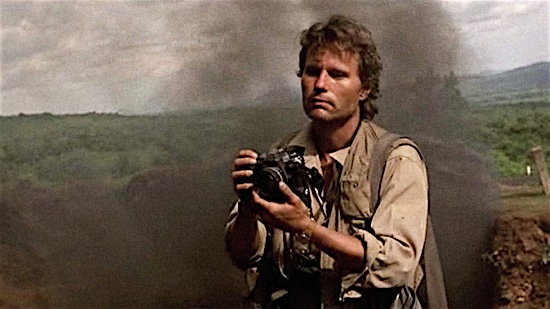
An undercurrent of inevitability carries Salvador all the way to where you know it’s bound to go. Co-written by director Oliver Stone and photojournalist Richard Boyle, the film loosely chronicles the exploits of freewheeling Boyle (James Woods) and his dumpy Dr.-Gonzo-esque friend Doctor Rock (Jim Belushi) as they smoke, screw and drink their way into El Salvador in 1980, just as the Revolutionary Government Junta was consolidating power. While it dawns on the two half-cocked nomads just what kind of horror has engulfed the country and to what extent the U.S. government has supported the large-scale oppression of the Salvadorans, war unfurls around them, rendered bluntly and with an almost total dearth of drama by Stone. When a Salvadoran death squad assassinates Archbishop Óscar Romero (José Carlos Ruiz) mid-sermon, Stone portrays it as if nothing is sacred anymore; by the time Cathy Moore (Cynthia Gibb, representing a group of slain U.S. missionaries in 1980), a friend of Boyle’s, is raped and murdered by the El Salvadoran National Guard, Salvador has long abandoned all hope. And still, Boyle wanders the increasingly war-scarred country, like Max von Sydow in The Seventh Seal, finding nothing but pain and violence bereft of meaning, but committed to a duty: to capture what was going on, or simply to satisfy the same degree of American-bred ego that Stone was condemning in trying to witness such atrocities at all. Undoubtedly bleak, Salvador ends exactly as it should, with Boyle alone, adrift and powerless amidst the tide of forces he’ll never be able to grasp. —Dom Sinacola
50. Beasts of No Nation (2015)
Director: Cary Fukunaga

A harrowing descent into a modern-day heart of darkness, Beasts of No Nation channels Francis Ford Coppola’s Vietnam epic Apocalypse Now for its tale of one child’s recruitment into an African rebel battalion. Adapting Uzodinma Iweala’s novel with fearsome intimacy, writer/director Cary Fukunaga depicts his unidentified African setting as a mixture of lushly green forests, bullet-shattered villages and mist-enshrouded horizons—the last of which is due, at least in part, to the fires that rage throughout the countryside. Those conflagrations are the result of a conflict between government and revolutionary forces, the specifics of which the film, like its precise locale, leaves more or less vague. Fukunaga’s film is thus mired in a hazy, nightmarish fugue of violence and degradation, the director presenting a landscape of hellish depravity and amorality through the eyes of one young boy unwittingly swept up in his nation’s insanity. A coming-of-age saga twisted into unholy form, Beasts of No Nation eschews undue melodramatic manipulations (and avoids romanticizing its perversions) in charting Agu’s maturation into a pitiless soldier. —Nick Schager
49. The Longest Day (1962)
Director: Ken Annakin, Darryl F. Zanuck, Andrew Marton, Bernhard Wicki, Gerd Oswald

The most impressive of the multinational, star-studded WWII recreation epics to come out of Hollywood in the ’60s and ’70s, The Longest Day—a hulking product of collaboration between no less than five filmmakers, approaching D-Day from the British, French, German and American sides—takes a sweeping yet thorough cross-section look at what happened in Normandy on June 6th, 1944, across land, sea and air. As Operation Overlord was a massive display of military might, so The Longest Day is a spectacle of the wealth and power of the ’60s studio system, and the reserves Hollywood kept for the war movie back when the genre was at the peak of its popularity. For the French-speaking portion of the film, there is an espionage mini-thriller and a thunderous Commando assault on a seaside town. For the English-speaking portion, the biggest stars money could then buy, including John Wayne, Henry Fonda, Richard Burton and Robert Mitchum, and a large-scale storming of Normandy’s beaches unrivaled in scope even by Saving Private Ryan’s feted opening scene. And for the German-speaking segments, a surprisingly even-handed (and occasionally even lighthearted) portrayal of ill-prepared officers, out-of-their-depth Luftwaffe and the ordinary soldiers who from that point on would be forever in retreat. —Brogan Morris
48. Kanal (1957)
Director: Andrzej Wajda
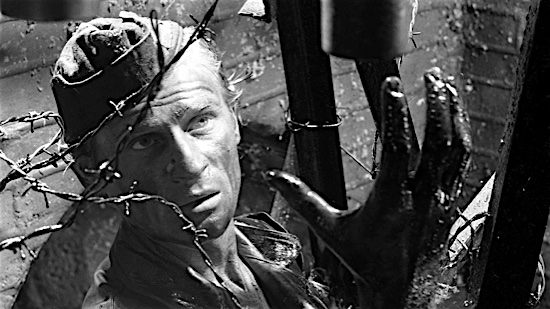
“Watch them closely, for these are the last hours of their lives.” The voiceover that opens Kanal, which simultaneously introduces us to a depleted company of the failed Warsaw uprising and foretells of its imminent grisly fate, powers Andrzej Wajda’s “resistance” movie with a morbid fascination. Aware of their slim chances of survival with the German army tightening its grip all the time, the remaining men and women of Lt. Zadra’s Home Army unit escape to the sewers, not because they think that offers much chance of survival, but because their instincts keep driving them to live, even if just for a few moments more. But the confusion and strange terror down there, in the foul winding tunnels of an underground maze of waste, make them a pitiful few last hours. All sense of time and geography is lost: it’s just mysterious bodies, wading in perpetual night through a river of shit. Sandwiched between A Generation and Ashes and Diamonds, as the least complicated and political of Wajda’s war trilogy, Kanal is as pure a portrayal of human desperation as one might find in the cinema. —Brogan Morris
47. Black Hawk Down (2001)
Director: Ridley Scott
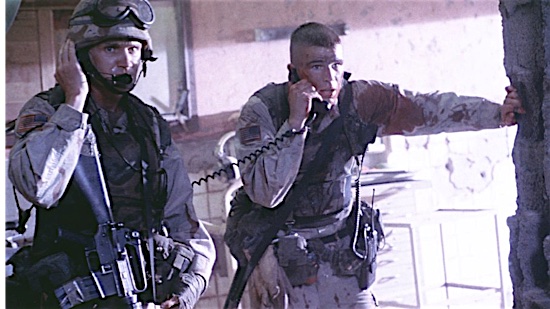
More than just a neat riff on Apocalypse Now’s Ride of the Valkyries sequence, stylistically it seems appropriate that Jimi Hendrix soundtracks the approach into Mogadishu by Black Hawk Down’s titular attack choppers: once Ridley Scott’s movie hits the Mog’, it’s almost psychedelic, a chaotic array of color and sound as Somali troops and a cast of Hollywood all-stars do battle in the searing sunshine. Based on the true story of one escalating firefight—that which emerged when the American plan to capture warlord Mohamed Farrah Aidid in 1993 went awry—Black Hawk Down allows Scott to focus in beautifully rendered detail on what happens when the cold, regimented modern military machine of the West meets a multitudinous foreign enemy on home turf. Not quite indictment or endorsement of modern warfare, Black Hawk’s still grizzly and draining, a near two-hour-long action sequence testifying how much punishment a human body can take, and how much death and destruction one can sow with modern firepower. —Brogan Morris
46. Die Brucke (The Bridge) (1959)
Director: Bernhard Wicki
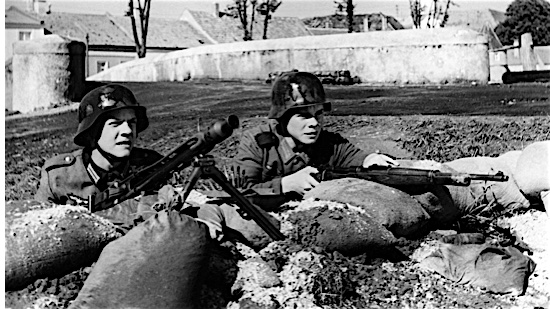
Set at the tail end of World War Two, Bernhard Wicki’s The Bridge is a proto-teen movie, only set in a besieged Nazi Germany on the verge of collapse. In this film, the schoolboys of a rural Bavarian town curse school, interact awkwardly with girls, learn from inspiring teachers, and fantasize about killing for the Fatherland. Seven eager chums eventually get their wish when Hitler’s Total War drafts them into a desperate endgame, the noble adventure continuing in the boy-soldiers’ brainwashed minds even as the rest of the German army retreats around them. Gleefully shooting at tin cans lined across the bridge they’ve been assigned to protect, these are children in uniform, playing at war; until, of course, they’re not, and the agonizingly protracted final battle does away with their innocence forever. —Brogan Morris
45. The Guns of Navarone (1961)
Director: J. Lee Thompson
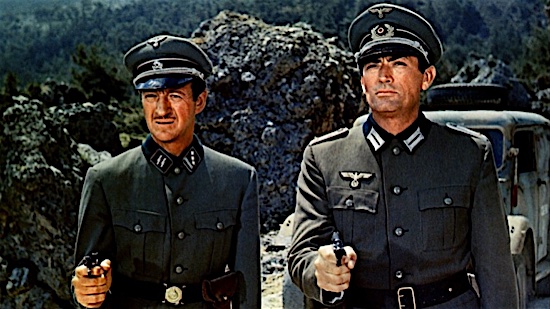
Depending on who you ask, The Guns of Navarone is a work of pure artifice, historical fiction that’s all fiction and no history. True, its source work, Alistair MacLean’s 1957 novel of the same name, was inspired by the Battle of Leros during World War II, but J. Lee Thompson’s film feels like its own beast, beholden to neither MacLean’s novel nor the war itself. Guess what? That’s fine. The Guns of Navarone is a stunner, no matter where it draws the pieces of its “men on a mission” plot from. Not incidentally, it’s also the first (one of, anyway) of many such movies to emerge during the 1960s, a niche in the war movie genre that multiplied over the course of the next twenty year following its release. You may cite the film’s cast, which starts with Gregory Peck, continues with Anthony Quinn, and fills out with Anthony Quayle and David Niven (among many others), as well as its character development, as the two key ingredients to its success; you may instead single out the action scenes, each as fluid and thrilling and as varied as the others; or you may choose to cheer for Thompson himself, whose second-to-none pacing keeps the film on rails without ever flagging or dragging or otherwise growing repetitive. Whatever. The truth is that you can’t take one of these elements away without affecting the others, and ultimately, that signifies The Guns of Navarone’s excellence as a harmonized piece of top-drawer action filmmaking. —Andy Crump
44. The Train (1964)
Director: John Frankenheimer
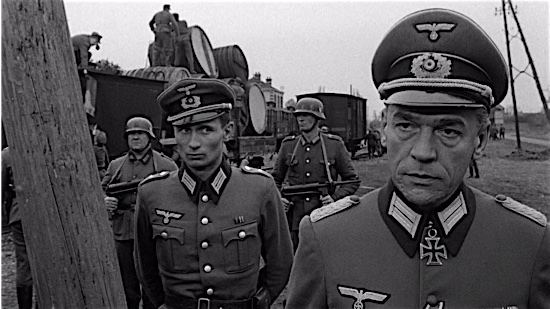
Here’s another picture that pointedly subverts accepted World War II pieties. John Frankenheimer’s 1964 action film pits Nazi Col. Franz von Waldheim (Paul Scofield) against French Resistance fighter Paul Labiche (Burt Lancaster) as the latter attempts to thwart the former’s efforts to sneak into Germany a collection of paintings stolen from a French art museum. But key to The Train’s provocative spin on simplistic good-versus-evil binaries is the way it characterizes both these characters. Von Waldheim may be on the wrong side of history, but he’s an aesthete who genuinely cares for the art he’s bringing back to this home country. Labiche, on the other hand, is a classic taciturn brute who cares more about revenge than about the art that he’s ostensibly rescuing, and by extension the beauty they represent amid a world gone mad. The beauty of Frankenheimer’s film is that it manages to sneak in such humanistic undercurrents within the confines of an electrifying action thriller, all the way to a final confrontation that leaves a bitter aftertaste even as the “right” party emerges victorious. —Kenji Fujishima
43. Men in War (1957)
Director: Anthony Mann
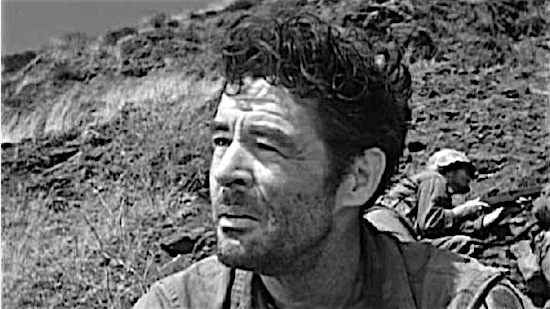
Men in War is a peculiar amalgam: part action movie, part psychological thriller and part existential odyssey. The mission is unremarkable, the men are unheroic and our characters speak in naturalistic military lingo, but there’s something off about the pilgrimage Lt. Benson (Robert Ryan) and his platoon make to take a hill deep in North Korean territory. Mann’s film possesses a spartan realism as well as a doomy, paranoid quality, with tilted angles and sweaty close-ups overlaying a story in which the characters are perpetually on edge, ever watchful of the dusty alien environment that keeps picking them off in broad daylight. In the end, as the outnumbered troop assaults the hill, Mann appears to be making a very simple point about the madness of war, but there’s something essentially mysterious and uneasy about the journey the director takes us on to get there. It’s almost like the road is a living thing creeping with menace, like the hill that awaits Benson’s platoon at the end of the path is a magnet drawing them to their doom. —Brogan Morris
42. MASH (1970)
Director: Robert Altman

Even now, it’s startling to watch Robert Altman’s 1970 farce in light of the long-running CBS television sitcom it inspired. Rather than the comedy-drama that Larry Gelbart’s TV show was (with a greater emphasis on drama in its later seasons), Altman’s film is uncompromising in its raucous anti-establishmentarianism, finding in its two rebel heroes, Hawkeye (Donald Sutherland) and Trapper John (Elliott Gould), merry pranksters willing to expose incompetence and hypocrisy in the army surgical unit in which they work. MASH may have been set during the Korean War, as the Richard Hooker novel on which it was based, but it’s clearly intended as a commentary on the Vietnam War going on at the time, with its two main characters people who were drafted into a conflict that they obviously care little about. As savagely funny as it still is in the ways it mines humor from the insanities of war, though, there’s an inner humanism that prevents it from being completely nihilistic. Unlike many of their colleagues and superiors, Hawkeye and Trapper John are skilled surgeons who genuinely care about saving people’s lives, reserving their bile for the most unthinking members of the military-industrial bureaucracy. MASH is a still-effective example of a film that finds humor in some of the least expected places, making us laugh in order to not cry. —Kenji Fujishima
41. Battleground (1949)
Director: William Wellman

Plenty of WWII films made during the war and in the immediate post-war period were, if not nakedly propagandistic, then at least psychologically simplistic, artificial and lopsidedly patriotic. Battleground, from WWI veteran William Wellman (directing) and Battle of the Bulge vet Robert Pirosh (writing from personal experience) seems like a direct response. There is sporadic combat, but mostly it’s about the waiting in between; one subplot involves Van Johnson’s private trying to find the time to cook the eggs a Belgian villager gave him on the way into the snow-blasted Ardennes. The equipment and uniforms look worn. There are no major stars to confuse the audience into thinking that any of the characters are individually heroic or special. Instead there’s a winning ensemble of character actors playing recognizably flawed people, homesick “doughboys” bantering and bitching about bad equipment, bad weather and the fact they’re in battle-torn Bastogne, not on leave in Paris as expected. In this movie, hot food is the real victory, and a man is as likely to be killed reaching for his boots in a firefight as he is making a glorious run against the enemy. —Brogan Morris
40. Play Dirty (1968)
Director: Andre De Toth

You’d be forgiven for thinking that Andre De Toth’s Play Dirty would be nothing more than a fruitless cash-in attempt on Robert Aldrich’s classic The Dirty Dozen, released the year before. After all, it shares 50% of the title and the basic “rogue leader takes crims on a suicide mission” plot. In fact, Play Dirty’s a tighter and vitally less-bloodthirsty film: whereas Aldrich’s Dirty Dozen are taught to love the army and hate the German, the men of Play Dirty, led by the dashingly amoral double act of Michael Caine and Nigel Davenport, never see their mission as anything other than FUBAR. With enemy tribes freely roaming the borderless desert landscape and morally lax hired guns positioned as the “heroes,” Play Dirty can feel closer to a western than a war movie—and one of Peckinpah’s at that. The pointlessness of man murdering his fellow man is noted in a whimper of a finale, a melancholic stroke that caps off one of the more entertaining men-on-a-mission movies. —Brogan Morris
39. The Dam Busters (1955)
Director: Michael Anderson
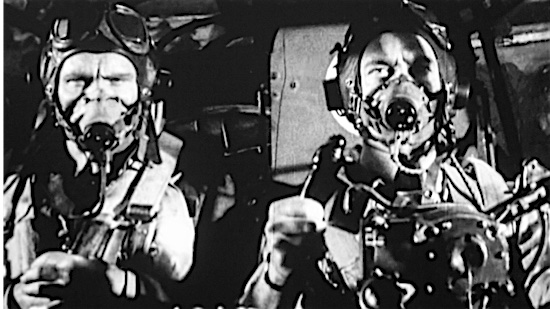
The best movies about obsession are, like their subjects, often entirely single-minded in approach. Michael Anderson’s very English war movie The Dam Busters spends most of its 124 minutes on the homefront, but each second is dedicated, as the inventor of the bouncing bomb Barnes Wallis’ (Michael Redgrave) every waking moment was, to the painstaking preparation and fine-tuning that would ensure mission success. As Wallis perfects his newfangled weapon, Wing Commander Guy Gibson (Richard Todd) trains a squadron to fly at suicidally low altitudes so they might drop Wallis’ payload on three crucial dams on the German Ruhr. It’s easy to get swept up in the momentum of Anderson’s film, which through its many dramatic roadblocks is always aiming true north towards the inevitable mission itself, a nerve-shredding, casualty-heavy raid that George Lucas would later snatch as inspiration for his Death Star trench sequence in A New Hope. The Dam Busters belongs to a class of British film that no longer exists—straitlaced yet charming, formal yet with bursts of cinematic invention, epic in scope yet intimately felt. Just don’t mention the dog. —Brogan Morris
38. The Ascent (1977)
Director: Larisa Shepitko
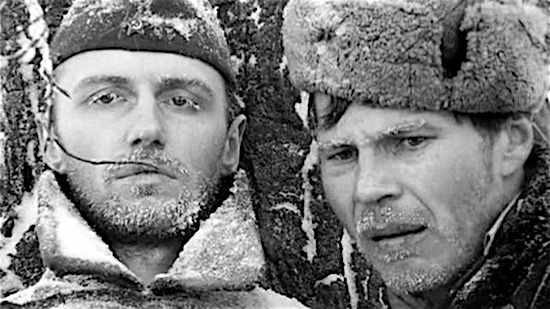
It’s uncertain how writer-director Larisa Shepitko managed to convince Soviet censors that The Ascent was just another atheistic Russian movie about the Great Patriotic War. What begins unremarkably—there’s a firefight in the snow, between partisans and German soldiers, before riflemen Rybak (Vladimir Gostyukhin) and Sotnikov (Boris Plotnikov) go in search of supplies for their starving unit and are captured—soon miraculously morphs into an explicit retelling of the tale of Christ’s sacrifice. Sotnikov becomes the Christ figure, Rybak his Judas and Portnov (Andrei Tarkovsky’s favorite actor, Anatoly Solonitsyn), a local collaborator interrogating on behalf of the Reich, their Pontius Pilate. The asceticism (lone figures and structures are flanked by endless snow, the white stretching on like a frozen desert) and Shepitko’s extreme close-ups on alternately serene and anguished faces, bringing to mind Dreyer’s The Passion of Joan of Arc, add up to an experience that feels almost religious. Down to the bones, it moves and enraptures. —Brogan Morris
37. Where Eagles Dare (1968)
Director: Brian G. Hutton
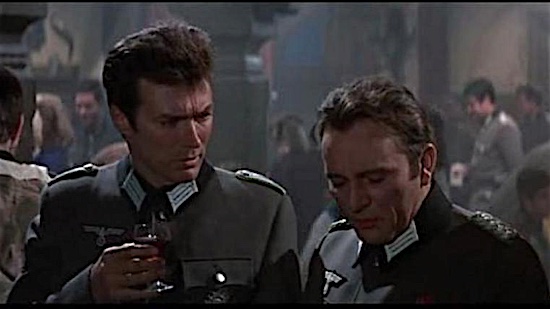
The kind of movie that lazy weekends are made of, Where Eagles Dare-concerning a crack team of Allied troops, disguised as German soldiers and tasked with rescuing a U.S. general from a Bavarian fortress in the winter of ’43—wears its own dispensability with pride. It’s a child’s afternoon playing with their toy soldiers come to life, with all the disposable baddies, indomitable mission commanders (played by Richard Burton and Clint Eastwood, both practically glowing with star power), gobsmacking twists and intricate set-pieces one could dream of. Director Hutton makes the enemy as dastardly as possible, so that we might cheer when our heroes unblinkingly explode a German base, or when Burton’s Major Smith drops a bad guy hundreds of feet off a cable car, or when Clint Eastwood’s Lt. Schaffer mows through a ceaseless line of Nazis with a pair of submachine guns. “Throwaway” as a term of affection was invented for pictures like this. —Brogan Morris
36. The Human Condition (1959-1961)
Director: Masaki Kobayashi
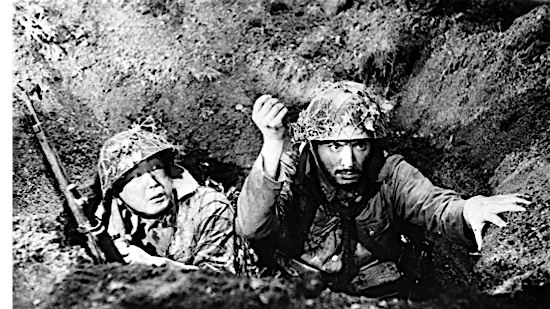
Masaki Kobayashi’s near ten-hour monolith requires commitment. One must prepare not just for the epic length, but for the film’s relentless assault on the notion of human goodness, by the end obliterated by a mountain of evidence to the contrary as experienced by one man. Newly married and fresh out of university, Kaji (Tatsuya Nakadai) soon discovers it’s a lonely world for a righteous utopian. On his journey through the cold, authoritarian quarters of Asia in WWII, Kaji unsuccessfully tries to bring his socialist ideals to his role as supervisor of Chinese prisoners at a Manchurian forced labor camp; suffers through all manner of indignities and physical trauma when he’s conscripted into the Japanese army; and finally finds himself wandering through a war-ravaged China into a Soviet POW camp, his body frail and his soul corrupted. It’s all realized in ravishing monochrome, but Kobayashi’s film can’t help but be a difficult watch, as is to be expected from a filmmaker committed to covering the proverbial life, death and everything in between over the course of 579 minutes. Renowned British film critic David Shipman called The Human Condition “unquestionably the greatest film ever made,” which is a matter for debate, but anyone willing to invest the time and energy will indeed find an unparalleled experience. —Brogan Morris
35. Waltz with Bashir (2008)
Director: Ari Folman
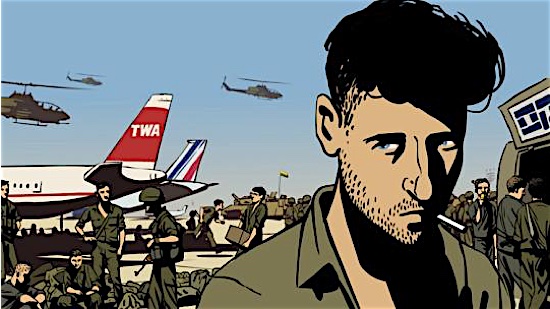
As much about memory’s hallucinatory inventions as the facts of the 1982 massacre at a Palestinian refugee camp in Beirut by the so-called Phalangist Christian militia, Ari Folman’s animated Waltz with Bashir begins with 26 barking dogs rushing through a city—from there, the emotion builds, relentlessly. Though Folman, a veteran Israeli documentarian, calls Bashir a documentary based on the interviews at its core (mostly with fellow soldiers), his cameras go places the handiest cinematographer could never venture: Beams of light bend between branches during a forest battle, and the dream images of men rising naked from the sea—while balls of fire fall from the sky—are just as real as the chasm-like blank spots in Folman’s mind as he reconstructs his mission into Lebanon. Powerful beyond a doubt, especially during a fourth-wall shattering climax, Waltz with Bashir borrows the visually manifest mind games of Richard Linklater’s Waking Life or A Scanner Darkly and dances them to the deep end. —Jesse Jarnow
34. Downfall (2004)
Director: Oliver Hirschbiegel
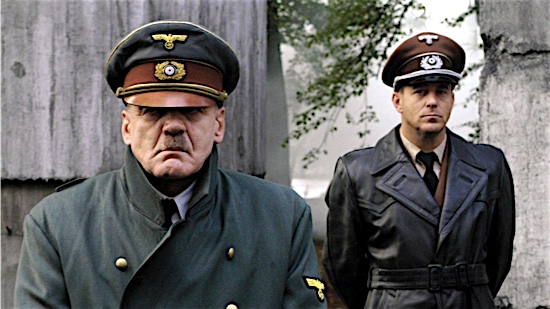
It’s a curiously human trait, our need to laugh in the face of evil—and that Downfall spawned a million parody videos perhaps speaks of how unsettling Oliver Hirschbiegel’s war-bio is. Here is a film that takes us into the heart of darkness in maybe the darkest time in human history, Adolf Hitler’s Berlin bunker at the end of WWII in Europe, and makes the mastermind of it all our company for two-and-a-half hours. More uncomfortably, the film makes a murderous dictator something approaching sympathetic, his hands uncontrollably quivering (possibly as a result of the onset of Parkinson’s disease), his mind paranoid and deluded that victory is still within grasp, as all around the city explodes and his soldiers privately prepare for life after the Reich. Bruno Ganz’s is the definitive screen portrayal of Hitler, a portrayal that courted controversy on the film’s release because it dared suggest there was humanity to one of history’s greatest monsters. His Hitler is ruthlessly inhumane and, as seen in that YouTube-famous scene, given to apocalyptic rages, but he’s also affectionate towards loved ones and kindly to his most loyal servants. It’s a fascinatingly complex depiction of a pathetic tyrant, in an all-round riveting account of a regime’s last days. —Brogan Morris
33. Black Book (2006)
Director: Paul Verhoeven
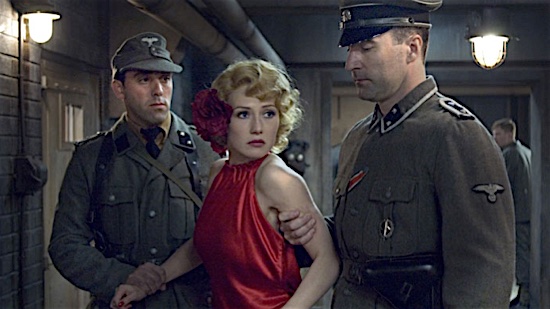
Leave it to Paul Verhoeven to puncture standard good-versus-evil sanctimonies during wartime, and to do it in as vulgar and trashy a manner as possible. Not that his 2006 epic Black Book is another Showgirls. This film—his first Dutch production since 1983’s The Fourth Man—is “classy” compared to much of his U.S. work: a sweeping, handsomely mounted period adventure yarn full of violent shoot-outs, sexy seductions and last-minute betrayals. With its irreverent tone and populist idiom, this would have fit quite nicely in mainstream U.S. multiplexes. Underneath its unabashedly crowd-pleasing surface, however, is a dark vision of the moral complexities World War II brought out on both sides. Here, not all of the Nazis are purely evil; one of them—Ludwig Müntze (Sebastian Koch)—is, in fact, Black Book’s romantic lead, a kind-hearted Nazi with whom vengeful Dutch resistance spy Rachel Stein (Carice van Houten) falls in love. And some of Rachel’s fellow resistance fighters are anti-Semitic themselves. There’s a keening moral intelligence in Black Book that makes it as troubling as it is mightily entertaining. In other words, it’s Paul Verhoeven at his provocative best. —Kenji Fujishima
32. The Big Red One (1980)
Director: Samuel Fuller
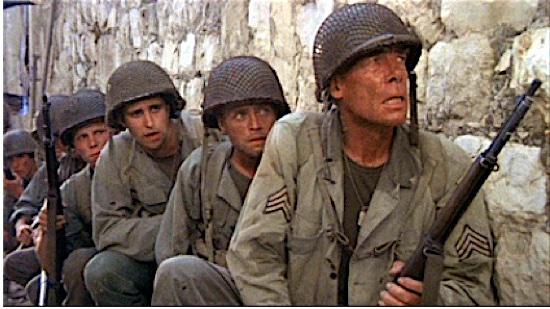
The Big Red One feels like the summation of all Sam Fuller took from his numerous careers. It has the eye for detail and human drama of a former journalist; the tough economy of an ex-pulp novelist; the casual ingenuity and resourcefulness of a B filmmaker of more than 30 years; and the been-there verisimilitude of a decorated WWII veteran. A collection of sensational war stories mixed in with Fuller’s own experiences as an infantryman for the 1st Infantry Division, The Big Red One is an intimate sort of epic, taking us from Africa to Italy, from France to Belgium, from Germany to Czechoslovakia, but always keeping the focus narrowed to Lee Marvin’s grizzled sergeant and his four most loyal dogfaces (including Mark Hamill and Robert Carradine, as Fuller’s stand-in). Observed alongside this bickering crew the absurdities of war don’t seem so harsh, their wry commentary keeping Fuller’s biting film surprisingly light—until a final sequence set at the liberation of Falkenau concentration camp finds Fuller confronting the horrors he personally witnessed with unvarnished emotion. —Brogan Morris
31. The Hurt Locker (2008)
Director: Kathryn Bigelow
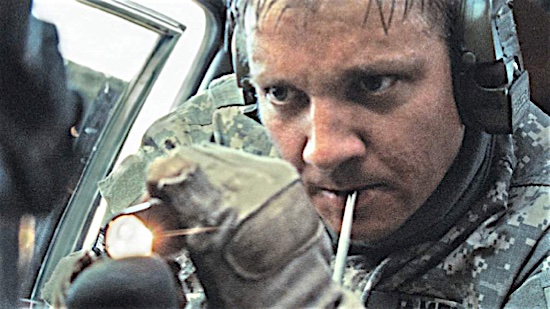
Kathryn Bigelow’s Zero Dark Thirty may have been more ambitious in its step-by-step chronicle of the efforts to find and kill Osama bin Laden, but her preceding War on Terror film, The Hurt Locker, perhaps remains the more resonant achievement. It’s essentially a character study in the guise of an action movie, with Bigelow’s subject Staff Sgt. William James (Jeremy Renner), a devil-may-care maverick who not only has a knack for disarming bombs, but loves doing it to a reckless degree. Beyond its hair-raising action and suspense set pieces, much of the film’s drama is driven by the tensions James’s hot-dog tendencies create between himself and everyone around him. But perhaps the film’s most noteworthy achievement lies in the way Bigelow uncannily inhabits James’s perspective while also standing outside of it. When, in its quiet epilogue, James finds himself immediately bored by suburban life and itches to return to the adrenalized theater of war, after nearly two hours of relentless nerve-wracking tension, we in the audience feel the same sense of stagnation he does. “War is a drug,” says journalist Chris Hedges in a quote that opens the film. In The Hurt Locker, Bigelow makes us understand that perspective in the most visceral way possible, to truly revelatory effect. —Kenji Fujishima
30. Empire of the Sun (1987)
Director: Steven Spielberg
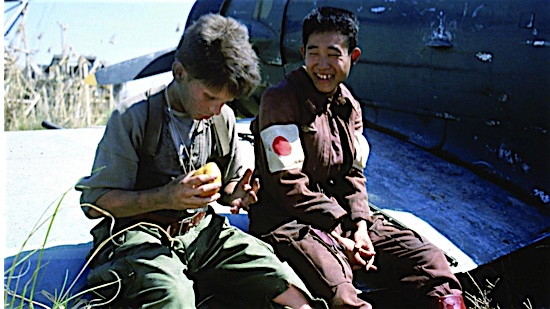
It was the most unusual of creative marriages: Steven Spielberg, then best known as a director of family fare, and J.G. Ballard, controversial author of macabre social horror novels. But in recalibrating Ballard’s semi-autobiographical war book Empire of the Sun as a dark fairytale, and in dipping his toe into darker waters prior to diving in with Schindler’s List, Spielberg made one of his most mature and moving works. It’s WWII through the eyes of a hyperactive child: to Jamie (Christian Bale, at 13 giving one of his very best performances), freed from his upper-crust English bubble when Japanese forces invade his Shanghai home and throw him in an internment camp, wartime is a playground. Absent judgmental parents and teachers, prison is a place for an imaginative young boy to run wild. Sneaking into the neighboring Japanese airfield is a game of hide and seek, while the flash of the atomic bomb is the soul of a fellow prisoner ascending up to heaven. It’s touching stuff, and Spielberg for once doesn’t blow it with a forced happy ending, preferring to finish on an ambiguous note: is Jamie saved, or lost forever? —Brogan Morris
29. The Dirty Dozen (1967)
Director: Robert Aldrich
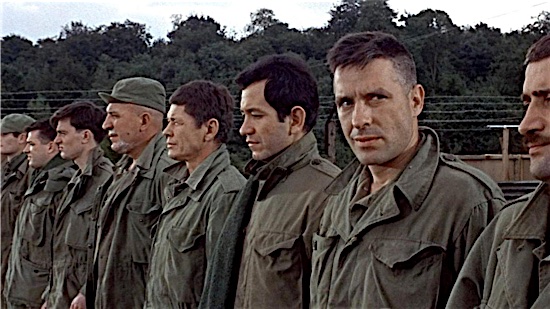
Imitated by many and bettered by none, Robert Aldrich’s The Dirty Dozen is the greatest men-on-a-mission movie not because it has the coolest action sequences—though the final showdown between the dozen and German forces at the French chateau is a fine bit of mayhem—but because it so capably finds a balance between nihilistic fun and viewer investment in its characters’ welfare. The first two-thirds is full of goofery, as a none-more-Lee-Marvin Lee Marvin whips a group of unrepentant criminals (including Charles Bronson and John Cassavetes, stealing every scene with his jackal’s grin) into shape for a mission in Nazi-held France, but the final third has the film take an abrupt turn, as our charming reprobates are picked off whilst slaughtering a house full of partying Germans—officers, their wives and all. A snappy, studio-lot, heroes-and-villains war movie with a wickedly subversive tone and that nasty finale, The Dirty Dozen fascinatingly straddles the Old and New Hollywood eras. 1967 was the year things started to really shift in American cinema, and The Dirty Dozen’s queasy, morally murky climax announces the sea change in spectacular fashion. —Brogan Morris
28. The Great Escape (1963)
Director: John Sturges
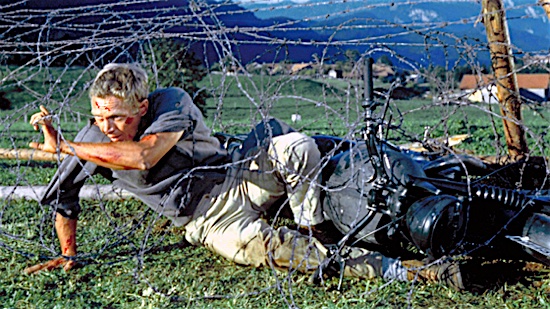
The nonfiction, real-life mass escape from a Nazi detention camp in Poland was presumably nowhere near as charismatic as John Sturges’ awesomely cast film adaptation, but that’s okay. The film doesn’t bring anything especially new to the cinematic examination of the war. That’s okay. It’s escapism? Well, it’s about escaping. What makes this film a high-stamina classic is largely its amazing ensemble cast, which includes Steve McQueen, Richard Attenborough, Charles Bronson, James Garner, James Coburn and Donald Pleasance. This band of POWs work together as a film ensemble as well as they work together to execute their impossible escape-each character bringing a different skill set and a different viewpoint to an effort that can only succeed if they all accept their differences and work together. The film has a rather slow start, which some people feel is a weakness, although it’s arguably valid for the character development and relationship development that are key to our desire to see these guys succeed. Despite its laconic pacing in the first half (which one could argue is a thematic underscoring of the frustrating and frightening suspension of being a POW, only diffused and channeled into action when they see a potential path to freedom), it remains a masterpiece of the action genre. It was also the film that put Steve McQueen on the map. I’m sure uncountable numbers of young men walked out of the cinema determined to buy a motorcycle after watching McQueen’s iconic escape ride. They don’t all make it, but they sure make you feel invested in their plan. —Amy Glynn
27. The Killing Fields (1984)
Director: Roland Joffé
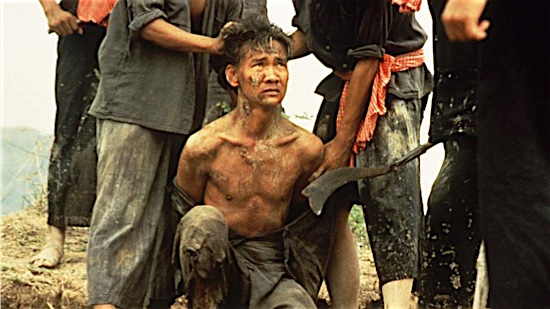
The Killing Fields is yet another love story set at a time of war, only this time it’s not two star-crossed romantics divided by conflict but two journalists, colleagues who form a rare bond against the backdrop of one of the grisliest scenes in modern history. It’s Phnom Penh, 1973, and reporters Sydney Schanberg (Sam Waterston) and Dith Pran (Haing S. Ngor) are making names for themselves bagging scoops on the overspill of the Vietnam War into Cambodia, until Viet Cong offshoot the Khmer Rouge takes control of Cambodia and Sydney flees, leaving the native Pran trapped behind. What follows—a systematic slaughter that claimed a quarter of the Cambodian population—is shockingly depicted, with the level of human cruelty and 1984-like totalitarianism on display lending the film an unreal, almost dystopian science fiction vibe. The cast are terrific, especially Waterston and an Oscar-winning Ngor, who in the second half gives what amounts almost to a great silent movie performance, the actor’s eyes telegraphing deep fathoms of inner pain—perhaps his character’s and his own, as he recreates atrocities the likes of which he personally witnessed. —Brogan Morris
26. Ran (1985)
Director: Akira Kurosawa
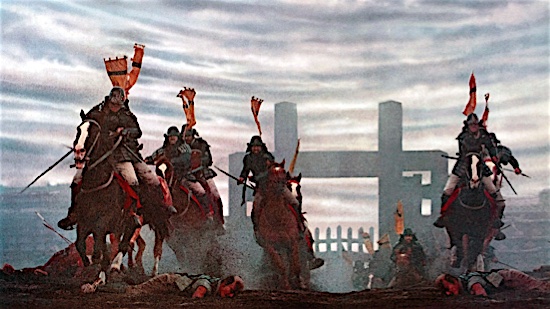
What kind of person takes Bill Shakespeare’s King Lear, arguably one of the harshest works in his bibliography, and embarks on a creative mission to make that story even harsher? Akira Kurosawa, of course, who in 1985 decided to tickle himself by making Ran, less an adaptation than it is a full-scale remodel of Shakespeare’s text: Kurosawa relocates the action to Sengoku-era Japan from Britain, changes Lear into the pernicious Hidetora Ichimonji, turns his daughters into sons, and generally speaking layers so much tragedy upon the founding tragedies of the Shakespeare play as to make it seem sunny by comparison. But does it qualify as a war movie? War does creep across Ran’s frames, slowly at first and increasingly more so once the first hour passes, but it is perhaps misleading to describe Kurosawa’s action scenes as such. It’s more accurate to think of them as massacres, really, violent, terrifying, and deafening montages of carnage where soldiers slaughter one another and onlookers decide it’s better to off themselves than await the blades of their attackers. War is always an ugly affair, but Kurosawa’s vision renders it maddening and ghoulish in ways most war films simply don’t. —Andy Crump
25. Cross of Iron (1977)
Director: Sam Peckinpah
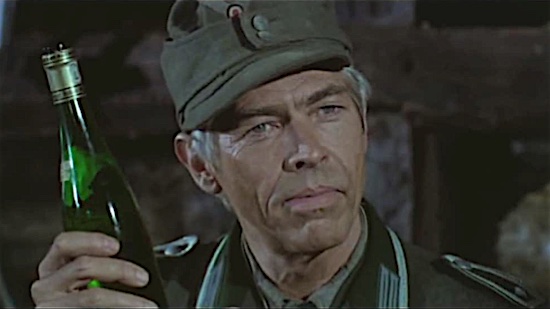
What pity that Sam Peckinpah made just one war movie proper in his lifetime. This explorer of masculinity, fascinated by male camaraderie and by gunplay, obsessed with mortality and the concept of heroism, always seemed a perfect fit for the genre. And so it proved with Cross of Iron, Bloody Sam’s anarchic and blackly comic traipse through Russian territory during the long German retreat of 1943. Grimy and cold, there’s not much of the pretty lyricism of Peckinpah’s westerns in Cross of Iron—here, death is not glorious but wasteful, while the mud-brown/stone-gray color scheme is interrupted only by liberal splashes of thick red blood. Orson Welles thought it one of the best anti-war films he’d ever seen, and with good reason. The film closes on a freezeframe of James Coburn’s Sgt. Steiner cackling, as Maximilian Schell’s hopeless officer and soon-to-be Iron Cross recipient in the middle of combat asks Steiner how to reload his own weapon, Russian forces swarming all around them. The crushing absurdity of war has hardly been better summarized on film. —Brogan Morris
24. Three Kings (1999)
Director: David O. Russell

Three Kings is a war movie which, as it goes along, attempts to figure out what a war movie even is anymore. Set at the butt-end of the Gulf War, the film begins as an odd bacchanalia of boredom, contorting through a handful of genres and Desert Storm misadventures to arrive, inevitably, at the conclusion that Oh, Yeah, Actually Turns Out War Is Never Boring. Director David O. Russell has his faults—and even a cursory reading into this movie will give you plenty of anecdotes about how much of a heel he is—but he’s not too naïve to claim he can sum up that conflict and the U.S.’s role by portraying its participants as hedonists and potential career criminals, partying and plundering their way through a passive desert land with nothing better to do. So, as four soldiers (George Clooney, Mark Wahlberg, Spike Jonze and Ice Cube) embark on a Kuwaiti gold heist based on information found within an ass map, Russell explores what the responsibilities of these men could be when their only responsibilities—occupying, defending and killing—are no longer all that urgent. Camaraderie, brotherhood, moral fortitude: all of it gone from Russell’s wonky post-war flick, replaced with a refreshing sense of surprise all but extinct from most movies dealing with the same moral gray of modern warfare. —Dom Sinacola
23. Patton (1970)
Director: Franklin J. Schaffner

Watching Patton, Franklin J. Schaffner’s colossal biographical ode to one of World War II’s most renowned and most controversial military figures, you get the sense that George S. Patton would likely dig Schaffner’s work; the film doesn’t apologize for itself or for its subject’s actions and attitudes, much as Patton didn’t make a habit of apologizing for either unless directly ordered to by his superiors. There may be no more appropriate way to honor the man’s memory than that, to the extent that Patton can be described as an “honor.” The film doesn’t exactly flatter the general, per se, but straddles a line between hero worship and sober representation, letting Patton, and by extension George C. Scott’s commanding and iconic portrait of him, speak for himself without fear of condemnation or reprisal. As Patton is about Patton, so, too, is it about Scott, which makes sense: If you make a movie and name it after its central character, you’re also making it about its central performance, and so it’s good that Scott was up to the task of reincarnating the late general in all his egotistical, violent, callous and shockingly vulnerable glory.Patton is a war movie, make no mistake, but it uses the war movie blueprint for housing a character study of its protagonist. The results, almost half a century later, remain completely singular in the genre. —Andy Crump
22. Twelve O’Clock High (1949)
Director: Henry King

Regarding the punishing lengths that some American airmen went to in the early days of WWII, Twelve O’Clock High is a disarmingly frank examination of combat shock. Scenes set up in the sky are realized through a smart, seamless combination of claustrophobic studio work and archive footage, but most of the drama takes place on the ground, where, short on planes and men, the aim at Archbury airbase is to “take nice kids and fly em till they can’t take anymore.” The film conveys all the strangeness and anxiety of flying a winged steel tube into enemy territory to drop explosives, and praying to get lucky enough not to be blown out of the sky. It’s the strict General Savage’s (Gregory Peck) job to restore morale and get the men of 918th squadron fighting operational again, but even he has a limit in these conditions. Keep a close eye on Peck’s performance: at first it may seem one-note, but somewhere around the final act the mask of all-American resoluteness begins to slip, before the actor makes an astounding left-turn in the closing moments that still ranks among cinema’s most heartbreaking depictions of combat fatigue. —Brogan Morris
21. Ice Cold in Alex (1958)
Director: J. Lee Thompson
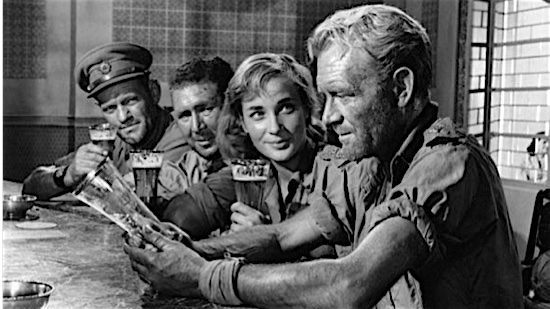
J. Lee Thompson’s Ice Cold in Alex, which situates us in Libya in 1941, might be the hottest black-and-white picture ever made. Overcoming the natural coolness of the monochrome image, the fierce heat of the desert is felt in its every frame, of bright sand-paved landscapes and sweating bodies. The palpable prickliness is an ideal set-up for the relief John Mills’ motley ambulance crew long for, as they pass minefields and German military patrols on the no-man’s land from Tobruk to British-held Alexandria, where the frosty beer anticipated even by the very title awaits. A small-scale film, Thompson’s focus on universally relatable sentiments—the soldier here longs not for action or glory, but simple home comforts after a job well done—makes the film feel huge. In its final minutes, this thriller reveals itself as a touching ode to friendship, as our unremarkable heroes sink their ice cold lagers in a long-awaited moment of release, and one of their number is forgiven in a rebuke to military protocol—another minor, humanist gesture which Thompson somehow manages to make massive. —Brogan Morris
20. Master and Commander: The Far Side of the World (2003)
Director: Peter Weir
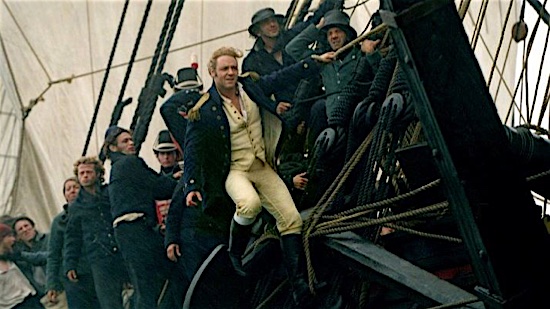
The pilot for one of the greatest movie franchises that never was, Peter Weir’s Napoleonic War adventure plays a long game of cat-and-mouse over two oceans, between a French vessel and the British HMS Surprise. The film takes great pleasure in old ways: it luxuriates in the myths and salty humor of Georgian mariners, gets swept up in the pre-WWI mentality of war as a flag-waving lark and, in a brief excursion to the Galapagos Islands, pines for the days of analog exploration. This is a feel-good film with a high body count—Weir and his cast of character actors take great pains to ensure the dozens of seamen are keenly and affectionately drawn to a man, so that each limb-endangering injury, each fatality is felt—thanks in large part to the squabbling chemistry between Russell Crowe as the ship’s driven Captain Aubrey, and Paul Bettany as its stern doctor. Through them it very nearly becomes a buddy movie, with the pair constantly nit-picking and bantering, but at the end of the day always reaffirming their friendship with a violin/cello jam. A match this good deserved a sequel, but the one movie we got is good enough to savor. —Brogan Morris
19. Fires on the Plain (1959)
Director: Kon Ichikawa
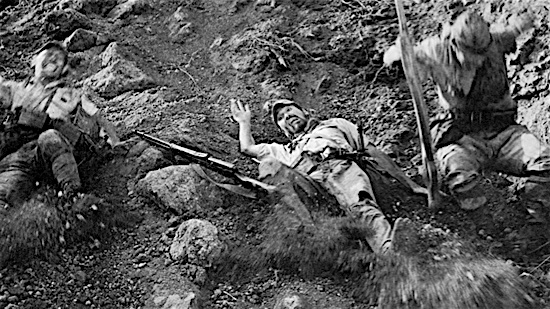
In Kon Ichikawa’s Fires on the Plain, Tamura (Eiji Funakoshi), a Japanese infantryman with consumption, makes a directionless pilgrimage through the Philippine jungle, looking for means to survive following the Japanese army’s defeat by U.S. forces in the region. Forced into an ascetic life, Tamura’s journey becomes a kind of religious experience—retaining his soul means sharing with others and not resorting to cannibalism as his fellow soldiers do, his body wasting while he clings onto his humanity as though that alone will keep him alive. A platoon of Japanese soldiers clamber over each other in the night like bugs, lit up by the enemy tanks about to decimate them; a dying soldier hungrily eats a handful of mud. Almost everything, from the dread-heavy score to the frighteningly dazed performance by Funakoshi (the actor reportedly ate so little in preparation that filming halted for two months while he recovered), tells us to abandon this savage epic. Yet its perverse beauty is hard to turn away from. —Brogan Morris
18. The Bridge on the River Kwai (1957)
Director: David Lean
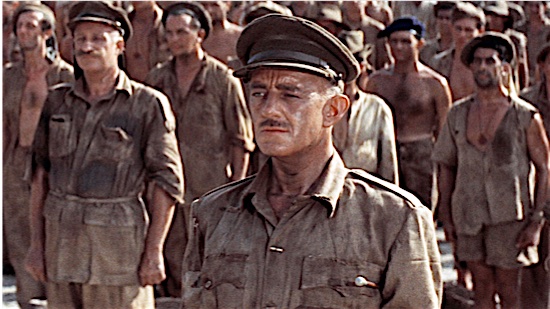
A frequent contender for the “greatest film of all time” crown, this adaptation of Pierre Boulle’s novel Le Pont Sue La Riviere Kwai is directed by the magnificent David Lean and stars William Holden, Alec Guinness and Sessue Hayakawa. Though fictional, the work is based on the construction of the Burma Railway in 1943, and was filmed on location in Sri Lanka (then Ceylon). It won seven Academy Awards, including Best Picture (and in an interesting side-note, a Best Adapted Screenplay Oscar for Boulle, who didn’t write the script, but had to be credited because the actual writers, Carl Foreman and Michael Wilson, were on the Black List at the time). The film chronicles the convergence of British soldiers in a Japanese POW camp led by Colonel Saito (Hayakawa), an intense and often sadistic officer. The ranking British officer, Lt. Colonel Nicholson (Guinness) is so by-the-book that he philosophizes about whether his men have a duty to try to escape, and nearly starves to death in a stand-down with Saito over adherence to the Geneva Convention. Complicating the mix is American Navy Commander Shears (Holden), a cynic who thinks Nicholson is insane for his dogged dedication to the rules in a clearly lawless situation. Saito is desperate to complete construction of the bridge (he’ll be forced to commit ritual suicide if he doesn’t), and of course, his war prisoner workforce are more interested in sabotaging the project than complying. Shears escapes, only to find himself recruited by a British commando unit charged with detonating the bridge. Except Nicholson has gone kind of Stockholm Syndrome and become obsessed with making a Great British Work of Engineering for the Japanese army. It ends in a tragic collision that’s been referenced, parodied and studied for generations. The production ruffled a lot of feathers—the British resented their depiction in the film and many deemed it anti-British (Alec Guinness included). Japanese critics resented the implication that they were incompetent engineers. David Lean frequently clashed with his British cast members, especially Guinness. At one point Lean fell into the river and narrowly escaped drowning. Decades before Apocalypse Now, this was a war film that was beset with onion-layers of internal battle. But Lean’s technical perspicacity is unwavering, the performances of the principal characters nuanced and multi-dimensional. No one’s a hero; no one’s a villain. Also: everyone’s a hero and everyone’s a villain. The film remains one of the most enduring WWII films largely because it takes a layered and sympathetic look at what constitutes courage, duty and the human survival instinct, which can take a multitude of forms. —Amy Glynn
17. The Deer Hunter (1978)
Director: Michael Cimino

Ah, The Deer Hunter, a movie of grand ambition and messy politics, one that critics exalt for its thoughtful depiction of working class Pennsylvanians while in the same breath condemning it for its racist one-sidedness and ponderous ambiguity. But despite Michael Cimino’s shortcomings, with The Deer Hunter he created a film truly unlike any other, an episodic saga that captures what Pauline Kael eloquently called “poetry of the commonplace” while also boiling over with anti-war sentiment and palpable rage regarding American troops’ experiences in Vietnam. The film’s first hour alone is a work of art, a fly-on-the-wall documentation of life in a Pennsylvania steel town (with eastern Ohio mostly standing in), as a group of friends including Nick (Christopher Walken), Michael (Robert De Niro) and Julie (Meryl Streep) prepare for two key events: a large, raucous Russian Orthodox wedding and the imminent departure of the men for Vietnam, where they realize their lives will forever be changed. The film’s shocking second act, with its POW Russian Roulette games and Nick’s torturous break with reality, is of course its most memorable. But the scenes that bookend that horror are the ones that earn it a place on this list, and ground its most ghoulish and surreal sequences in the real sense of despondency that threatened to drown many communities in the wake of the war. —Maura McAndrew
16. All Quiet on the Western Front (1930)
Director: Lewis Milestone
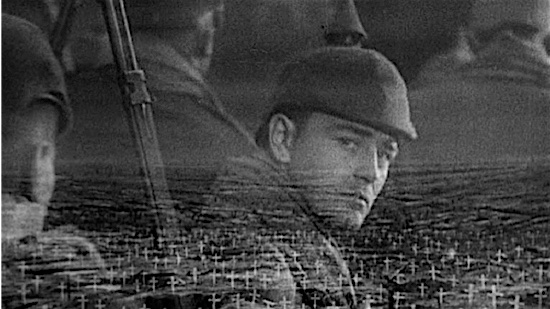
Such was the impact of Lewis Milestone’s pacifistic WWI drama: when the film was first released, Variety wrote that the League of Nations should show it around the world “until the word ‘war’ is taken out of the dictionaries.” Not surprisingly, the fascist regimes of Germany and Italy banned the movie—they feared the influence of its anti-war message, and, almost 90 years on, the pulverizing power of the film is obvious. All Quiet on the Western Front is ferocious, a Pre-Code deglamorization of war that, some nine decades ago, arguably made the final point on the profound horror of the trenches. The heroes of this tale start out as schoolboys, young Germans urged to the front by their professor, but—without the film ever sparing much time to contemplate just what’s happening—before long the class of ’14 are whittled down to just one veteran boy soldier, a witness in his teens to all the myriad ways men can die. Just out of the silent age, Milestone made a noise that can still be heard loud and clear. —Brogan Morris
15. Saving Private Ryan (1998)
Director: Steven Spielberg
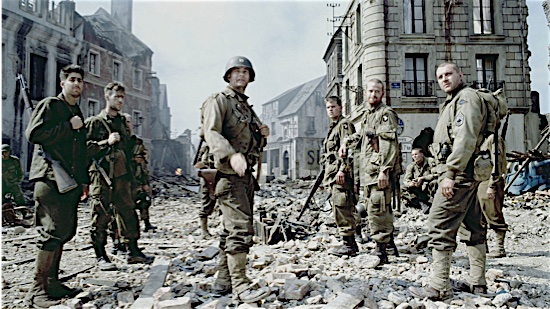
Despite its overwhelming scale, the economy of Saving Private Ryan is an astounding accomplishment of storytelling. Barely a year into founding Dreamworks—the studio he built with Jeffrey Katzenberg and David Geffen, essentially allowing him free rein over his creative output—and cuffed by the relative disappointment of Amistad, Steven Spielberg created a nearly three-hour imagistic portrait of Europe in the waning weeks of World War II, all without once allowing the nightmarish breadth of the conflict to overtake the characters at its heart. Twenty years later, and the film’s opening 30-minute salvo, detailing in documentary-like grit the D-Day invasion on the beaches of Normandy, still stands as iconic war filmmaking, unflinching but so pristinely focused on the sheer weight of lives lost that it’s a stymying watch even if you know exactly what you’re getting into—even if you’ve seen it before. Within that initial stretch, brutal and breathless, we learn all we’ll ever need to know about the people who inhabit this literally foreign landscape, each character (played by such folks as Vin Diesel, Barry Pepper and Giovanni Ribisi) presented with the precision of a master who’s discovered how best to balance all that historic weight. For us Millennials who first began to understand the extent of what our grandparents endured as we came of age (as we became the age our grandfather was when he left for war), Saving Private Ryan was an earth-shaking film from a director who’d already reared us on big, blown-out entertainment. For us and anyone else, the film is a near-perfect, heart-wrenching feat that must have been given, as was the film’s titular mission to Captain Miller (Tom Hanks), to Spielberg by fate itself. —Dom Sinacola
14. Full Metal Jacket (1987)
Director: Stanley Kubrick
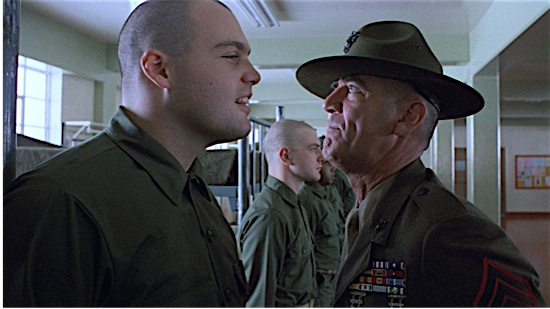
It’s a non-controversial opinion that Full Metal Jacket’s worth extends as far as its first half and declines from there as the film nosedives into conventionality. But the second chapter of Stanley Kubrick’s Vietnam horror story is responsible for creating the conventions by which we’re able to judge the picture in retrospect, and even conventional material as delivered by an artist like Kubrick is worth watching: Full Metal Jacket’s back half is, all told, pleasingly gripping and dark, a naked portrait of how war changes people in contrast to how the military culture depicted in the front half changes people. Being subject to debasement on a routine basis will break a person’s mind in twain. Being forced to kill another human will collapse their soul. Really, there’s nothing about Full Metal Jacket that doesn’t work or get Kubrick’s point across, but there’s also no denying just how indelible its pre-war sequence is, in particular due to R. Lee Ermey’s immortal performance as the world’s most terrifying Gunnery Sergeant. —Andy Crump
13. Ivan’s Childhood (1962)
Director: Andrei Tarkovsky
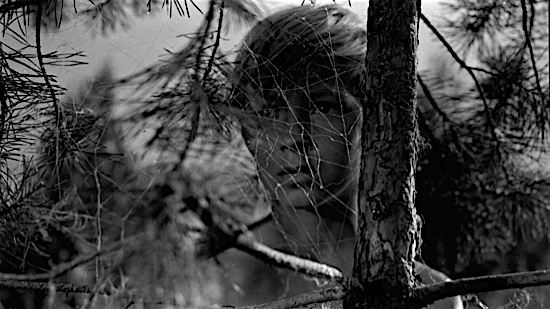
Tarkovsky fan Jean-Paul Sartre observed that, for the prepubescent veteran of Ivan’s Childhood, the world has become “a hallucination.” It’s why we view the film through an oneiric lens: it’s the only way our boy hero can interpret his Russia in the midst of war. An orphan whose family was executed by the Germans, a former Partisan and now a scout for the Soviet army, Ivan is coddled by the other soldiers in his unit, but they hope to nurture innocence in a child already made preternaturally old by war. This minimal story of Ivan’s Childhood’s is just the canvas on which Andrei Tarkovsky can arrange his luminous photography, around which the director can wrap his cosmic musings on existence. Beguiling long takes force us to ponder the trees, the water, the swamps between the German and Soviet outposts, always rained on by flares in the night. Tarkovsky’s compositions are magic, so perfectly calibrated and dense with thought they each carry the weight of an essay. No other war film looks and feels like this. No other war film ever will. —Brogan Morris
12. Das Boot (1981)
Director: Wolfgang Petersen

You can watch it as a feature, either the 150-minute theatrical iteration or the 208-minute director’s cut. Or, if you have the time, you can see it in its original uncut form, or as a five-hour miniseries. But in any version, Das Boot is the finest submarine movie in all of cinema. Only “movie” seems an inadequate description. Wolfgang Peterson’s breakout is an experience, a thing to endure alongside the solemn, silly, cynical men of the U-96. We the audience spend the days down there in the depths with the crew, stalking enemy vessels and tensing up under hull-busting pressure, petrified at the sound of approaching depth charges, elated at successfully escaping through into safe waters. Author Lothar-Gunther Buchheim considered his novel butchered, with Petersen’s film an unrealistic “re-glorification” of the German combatant in WWII, but there seems nothing glorious or inauthentic about Peterson’s adaptation. To the viewer, the U-96 crew’s excursions into fear and madness seem like perfectly reasonable responses to an unimaginable situation. —Brogan Morris
11. Army of Shadows (1969)
Director: Jean-Pierre Melville
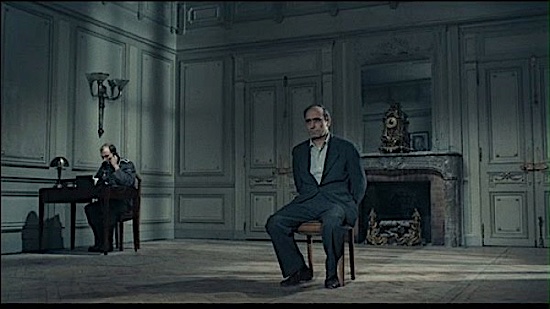
A story of those French citizens who for five long years resisted Nazi occupation, Army of Shadows is a black-and-white film made in color, Jean-Pierre Melville’s predominantly gray-blue color palette lending a chilly air to a decidedly bleak and minimalist saga less about the heroism of defiance and more about surviving the consequences of resistance. The film is as subdued as the phantom-like men and women fighting for reclamation of their land, visually as murky as the actions perpetrated by either side of the fight. Melville’s tenth was virtually unknown until 2006, when his film—widely derided at home in a divided France on initial release—finally opened in the United States to critical acclaim. In the wake of its relatively recent re-evaluation, Army of Shadows stands, along with Robert Bresson’s A Man Escaped and Louis Malle’s Lacombe, Lucien as one of the defining films about the French resistance. —Brogan Morris
10. Platoon (1986)
Director: Oliver Stone
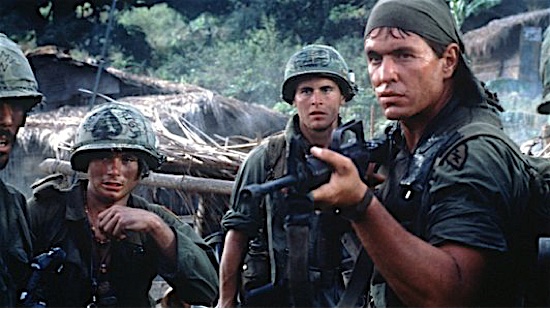
You can boil down Platoon to a single iconic image: Willem Dafoe, hands and arms held aloft as Vietnamese soldiers gun him down, his fellow infantrymen the sole audience to his grim and lonesome demise on the ground. Is he making an act of supplication in his final moments? Is he submitting to death itself? Or is his gesture meant to be interpreted as an acknowledgment of his helplessness, a pantomime outcry at his betrayal and abandonment? No matter how many times this scene plays out, its subtexts remain open to interpretation. What remains the same is our horror at Dafoe’s exit from the film, and what it means in context within the narrative. Platoon, like any Vietnam war movie, is unforgivingly brutal, a picture show of relentless barbarity that recreates one of America’s greatest self-made martial, political, and international debacles. Also like any Vietnam war movie, or any war movie general, really, it repurposes a host of atrocities as tense entertainment, folding the cathartic release of seeing the bad guy get what’s coming to him within the bloody details of America’s intervention in Vietnam. —Andy Crump
9. The Grand Illusion (1937)
Director: Jean Renoir
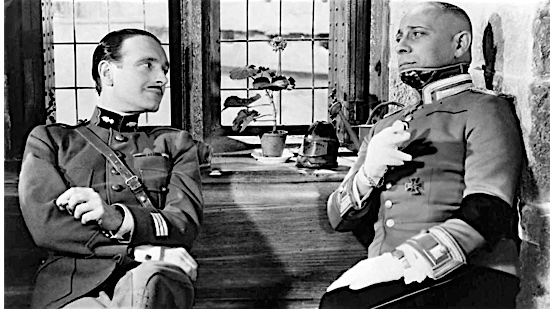
Made in the build-up to an even greater war, Jean Renoir’s WWI POW drama is a sincere call for unity between nations. The call would go unheeded of course, but 80 years filled with clashes and violent disagreements later, Renoir’s message prevails: class, nationality and creed are meaningless before our shared humanity. Just a decade on from the first talkie, Renoir made what today appears a strikingly modern film: naturalistic performances and dialogue, smooth camera movements and, most importantly, complex character dynamics. Every character in the film, through desperate circumstance, becomes allied with another from a walk of life they otherwise would never traverse. Most interesting is the relationship between the aristocratic de Boeldieu (Pierre Fresnay) and von Rauffenstein (Erich von Stroheim): they are French and German, prisoner and warden, but, as if two rare creatures forced to occupy the same cage, a friendship forms through mutual recognition that they may be among the last of their kind. Renoir’s depiction of an entire society through allegory is genius, his empathy almost superhuman. The Grand Illusion kills with kindness—it fulfills its duty as an anti-war flick not by showing battlefield horrors, but simply by asking: how can we be enemies when we have so much in common? —Brogan Morris
8. The Battle of Algiers (1966)
Director: Gillo Pontecorvo

A perfect meeting of story and style, Gillo Pontecorvo’s guerrilla warfare drama The Battle of Algiers reflects in its grainy docu-style the scrappy tactics of the combatants: the revolutionary Algerian National Liberation Front, executing police and civilians in cafes and in the streets, and the French governors and counter-insurgents, struggling to combat a threat to their existence in a land they rule but don’t fully understand. Like a great documentary would, The Battle of Algiers takes a coolly balanced and non-judgmental view of its subjects, coming down neither on the side of the radicals nor the colonialists, but in another way Pontecorvo’s raw newsreel design is deceptive: what appears improvisational is actually meticulously arranged. The director’s great achievement is that not a second of his film is without purpose, yet it unfolds as a constant surprise, almost as though the footage was not shot but discovered. —Brogan Morris
7. Paths of Glory (1957)
Director: Stanley Kubrick
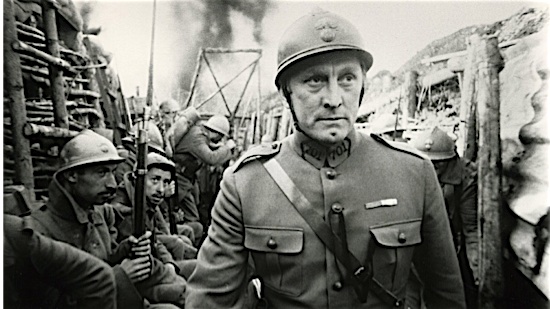
François Truffaut is famously (and maybe erroneously) credited as having said, “There is no such thing as an anti-war movie.” He did say that he couldn’t make a war movie about Algiers on the basis that, “to show something is to ennoble it”; he also said that “every film about war ends up being pro-war.” If this is true then maybe Paths of Glory is the closest the movies will ever get to producing an anti-war statement, though Stanley Kubrick’s trim World War I opus is better qualified as being disdainful of war: You can sense Kubrick’s contempt for his antagonists seething from behind the camera, his righteous indignation at the unapologetic cowardice of the craven old men who send others off to die on the field of battle at their behest. Maybe Paths of Glory isn’t anti-war, but it is pro-human, a film that celebrates true dignity and honor by recognizing that one need not rush forth to meet their inevitable death to be brave. —Andy Crump
6. The Red and the White (1967)
Director: Miklós Jancsó
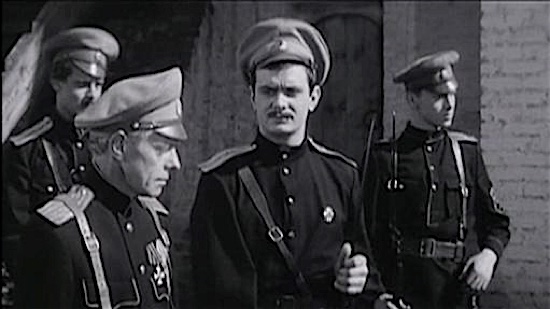
One of the most gorgeously fluid films ever made, Miklós Jancsó’s Russian Civil War snapshot is a Soviet production by way of a fiercely independent Hungarian auteur—all the opulent production and Herculean skill with the camera that characterized the best of the Communist Bloc’s filmmaking, minus the didacticism of its worst. Mosfilm for some reason agreed to finance it (before later re-editing, then banning it); it’s hard to see how the film’s fatalistic conceit, the narrative baton constantly passing from one faction and one character to the next as soldiers die at the hands of their “red” or “white” enemy, could ever have been viewed as anything other than explicitly anti-war. It’s a gallery of horrors—officers jumping to their deaths rather than being taken prisoner, captive soldiers used as moving target practice, civilian women forced to dance for their captors—made hypnotic by Jancsó’s sheer technique. Better than perhaps any other, Jancsó’s film makes the case for the utter wastefulness of war. All this death, and after 90 minutes, not a lesson learned. —Brogan Morris
5. The Life and Death of Colonel Blimp (1943)
Directors: Michael Powell, Emeric Pressburger
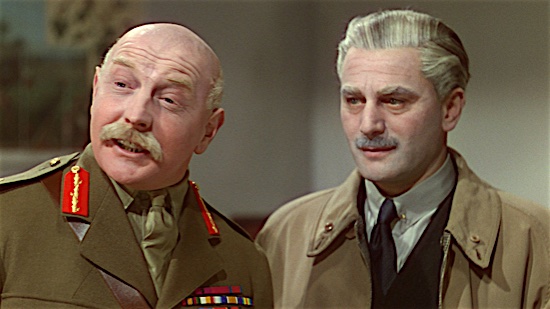
Surely the most remarkable film ever to take inspiration from a tabloid comic strip, The Life and Death of Colonel Blimp is a war movie that spans three wars yet never actually shows any combat, about two career military men on opposite sides who somehow remain lifelong friends. For the most part the film remains in Blighty, where the British Clive Wynne-Candy and Prussian Theo (the ever-transforming Roger Livesey and Anton Walbrook, both astonishing) return from the Boer War, see out the end of the Great War and find themselves respectively an old soldier out of time and an alien fleeing the Nazis at the outset of WWII. Colonel Blimp is many things. It gloriously satirizes its plummy, proper milieu and mournfully charts that period’s passing into history. It’s about how war in the first half of the 20th century lost its jingoistic appeal and brought about great political change, how conflict is cyclical and too often born out of stubborn pride, about growing out of dashing idealism into cynical old age, about obsessive love (there’s a Vertigo-esque role for Deborah Kerr, who plays a different object of affection for Candy in each timeline). Above all, it’s a WWII-era film by an Englishman and an Austro-Hungarian that emphasizes humanism over nationalism, powered by said pair’s ahead-of-their-time inventiveness. Few films have ever tried to say and be so much, and succeeded in saying and doing it all with such panache, lightness and wit. —Brogan Morris
4. Come and See (1985)
Director: Elem Klimov
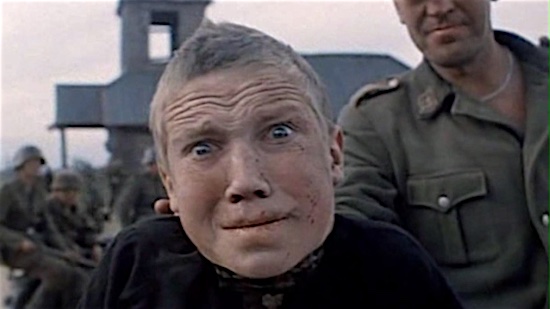
If the purpose of a war movie is to make war appear absolutely and totally unappealing, then Come and See might be the greatest ever made. Elem Klimov’s film is the war movie as expressionist horror, a diorama of violence and dreadful symbolism that’s also a cruel coming-of-age spectacle. Perhaps Klimov could only comprehend the genocidal reality of the Nazi war machine storming Belorussia through this hallucination of sound and imagery: corpse-piles attracting clouds of flies, dairy cows machine-gunned by tracers at dusk, forest bombing raids that leave the lead character’s (and the film’s) aural faculties muffled. Though we’re witness to atrocities, including a climactic annihilation of a Belorussian village that may be the single most effective anti-war scene in all cinema, the damage done to young hero Flyora (Aleksei Kravchenko) is what’s most unforgettable, as he enters the picture fresh-faced and idealistic and leaves it withered and hollow. The title is taken from a line in the Book of Revelation; the epic terror implied in the biblical quotation is absolutely fitting for this most harrowing of war movies. —Brogan Morris
3. The Thin Red Line (1998)
Director: Terrence Malick
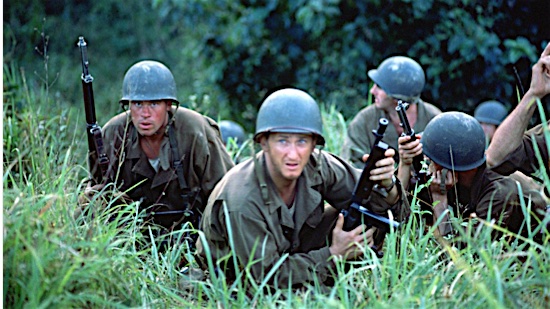
It seems unbelievable now that even an auteur as legendary as Terrence Malick actually secured financing to make poetry on the scale of The Thin Red Line. Pitched up on lush location in Australia and armed with a cast bursting with talent, Malick returned from moviemaking hibernation in 1998 with author James Jones’ story of a company of GIs battling Japanese forces in the paradise of Guadalcanal refracted through his own glorious lens. The result was an abstract and relentlessly contemplative epic, awash with gorgeous cutaways to jungle and beast, and—atypically for a filmmaker whose main fixation has always been the environment his characters reside in—chock-full of great acting. (The performances are faultless to a man, but a terrifically zen Jim Caviezel and a perpetually enraged Nick Nolte take the prize.) Hardly ever can a film sustain that aching feeling of raw emotion across its entire running time; this almost three-hour masterpiece does. —Brogan Morris
2. Lawrence of Arabia (1962)
Director: David Lean
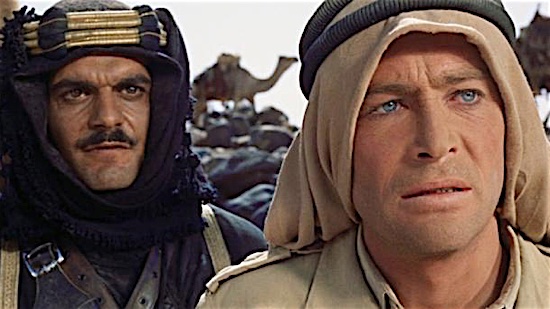
“And introducing Peter O’Toole.” Talk about a debut. Look up the word “epic” and you just might find David Lean’s marathon masterpiece about T.E. Lawrence in the Arabian Peninsula in WWI. Its run time is 222 minutes, so if you’ve somehow managed to get to this point without having seen it, plan accordingly but do see it, because there are really good reasons why this film was nominated for 10 Academy Awards (of which it won seven). Though somewhat romanticized and with some conflated or added or subtracted characters, this is a fairly nonfictional account of Lawrence’s story, in which he finds his loyalties divided between the Arab tribes and the British Army (Clashing cultures was a noteworthy preoccupation in Lean’s films, and opinion is somewhat divided on how successful he is at depicting them). A kooky maverick as far as the British are concerned and an untrustworthy outsider to the Arabs, he wins the favor of Prince Faisal (Alec Guinness), and leads a dangerous and daring attack on the Turkish military Aqaba with a multitribal Arab force led by Sherif Ali (Omar Sharif). And that’s all before the intermission. Lean was a director’s director with a fascinating visual sensibility, and the brutal, lethal Arabian desert is not only captured brilliantly by cinematographer F. A. Young, but in large part by composer Maurice Jarre’s brilliant score. There’s not a bad performance from the powerhouse cast, but what one has to wonder is what would have happened if the studio’s first choice had accepted, And Lawrence had been played by Albert Finney? O’Toole was an unknown when he was thrust into a demanding and intense lead role, and he is so riveting it’s hard to imagine anyone else under those robes. By turns bold and shattered, insouciant and wild, refined and desperate, he remains above all believable and deeply human-an unapologetically flawed hero (and wow, not too hard on the eyes, either). Yes, Lawrence of Arabia is an important, canonical film for its scale, its score, its technical achievements. But what really matters about it in the end is pure, and utterly masterful, storytelling. —Amy Glynn
1. Apocalypse Now (1979)
Director: Francis Ford Coppola
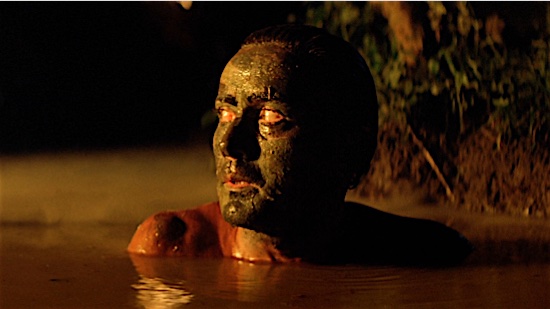
Let’s invoke Truffaut one more time, because his spirit feels as relevant to discussion of Francis Ford Coppola’s baleful adaptation of Joseph Conrad’s Heart of Darkness as to discussion of Paths of Glory. Maybe, if we take Truffaut at his word, Apocalypse Now can’t help but endorse war merely through the act of recreating it as art. But maybe that doesn’t stop the film from conveying Coppola’s driving theses: That war turns men into monsters, leads them on a descent into a primal, lawless state of mind, and that war is itself hell, an ominous phrase now made into cliché by dint of gross overuse between 1979 and today. If the film innately sanctions war by depiction, it does not sanction war’s impact on the humanity of its participants. In fact, Apocalypse Now remains one of the most profound illustrations of the corrosive effect nation-sanctioned violence has on a person’s spirit and psyche. It’s cute that in 2017, we’re okay with quoting this movie in gratingly awful AT&T commercials, or repurposing its period backdrop for the sake of making King Kong happen for contemporary audiences for a second time, but there’s nothing cute, or even all that quotable, about it. Apocalypse Now sears, sickens and scars; it’s a film that brands itself in our memories as only the grimmest displays of human depravity truly can. —Andy Crump
GET PASTE RIGHT IN YOUR INBOX
The best music, movies, TV, books, comedy and more.
-

-

-

-

-

-

-

-

-

-

-

-

-

-

-

-

-

-

-

-

-

-

-

-

-

-

-

-

-

-

-

-

-

-

-

-

-

-

-

-








































